














We are pleased to present Imagine Franklin 2035, Franklin County’s official comprehensive plan that serves as the guiding framework for the county’s growth and development over the next decade and beyond.
Franklin County continues to experience tremendous growth and change. Because signs indicate that this trend will continue into the future, we face the challenge of preserving what we love about our county while developing thoughtful strategies to accommodate and anticipate the needs of our communities and residents in the years to come.
Imagine Franklin 2035 lays out a realistic action plan to achieve the vision and prioritize the goals established by local residents, businesses and other stakeholders while capitalizing on existing opportunities and community assets. Priority issues include:
• Land use and natural resources
• Housing
• Workforce and education
• Community facilities
• Strengthening our urban centers
• Human services
• Movement of people/transportation
Addressing the recommendations set forth in Imagine Franklin 2035 requires a collaborative effort by the County, local municipal officials, leaders within our economic development and human services sectors, representatives at the regional, state and federal levels, community stakeholders, and, last but certainly not least, our residents. By working together, we can utilize our strengths to address challenges in order to achieve the vision we have for Franklin County.
We invite you to review Imagine Franklin 2035 and encourage you to join us as we work together to achieve our vision of Franklin County’s future.
Commissioner David Keller, Chairman
Commissioner John Flannery
Commissioner Robert Ziobrowski
County of Franklin Resolution 2023-16
WHEREAS, the Franklin County Planning Department has prepared a new County Comprehensive Plan in accordance with Sections 209.1 and 301 of the Pennsylvania Municipalities Planning Code, with said plan titled Imagine Franklin 2035; and
WHEREAS, the Franklin County Planning Commission at its regular meeting on July 27, 2023, recommended approval of the draft Comprehensive Plan (Imagine Franklin 2035) and referred it to the Franklin County Board of Commissioners for adoption; and
WHEREAS, the plan consists of a printed version of the full document and is complemented by an interactive, web based version that highlights the planning process, a future character area map to assist with future development and land use decisions, and a three-year implementation strategy that can be found at (compplan.franklincountypa.gov); and
WHEREAS, as part of the preparation of this new comprehensive plan, the Planning Department staff and their consultants held numerous public meetings to solicit input on Imagine Franklin 2035 and the goals for the County; worked with a steering committee with representatives from the public, non-profit, and business communities; met with many municipalities and interest groups on the plan; sent the draft plans to all municipalities and school districts within the County as well as all abutting Counties, municipalities, and school districts; and considered the comments received and incorporated appropriate revisions into the plan; and
WHEREAS, the Franklin County Board of Commissioners recognizes that it is essential for the health, safety and welfare of all County residents for Franklin County to have an up-to-date set of coordinated policies to guide the County’s physical development, preserve its natural and cultural resources, and make optimum use of its financial resources; and
WHEREAS, the County Comprehensive Plan will continue to serve as a policy guide for all units of Franklin County government; and
WHEREAS, the County Comprehensive Plan will continue to present a comprehensive set of County plans, goals, and policies for the use and guidance of regional, state, and federal agencies.
NOW THEREFORE BE IT RESOLVED, that the Franklin County Planning Commission and the Franklin County Planning Department certifies that it has prepared the comprehensive plan consistent with the requirements of the planning code; and
BE IT FURTHER RESOLVED, that the Franklin County Board of Commissioners adopt as official County Policy, in accordance with Section 302 of the Pennsylvania Municipalities Planning Code, a new comprehensive plan for Franklin County titled Imagine Franklin 2035 and direct the Franklin County Planning Department to transmit an accurate copy of the plan and a copy of this resolution to the appropriate County departments, municipalities, school districts, and agencies to ensure compliance with the Pennsylvania Municipalities Planning Code, and to other appropriate municipal, regional, state, and federal agencies.

County Commissioners
DavidKeller,CommissionerChairman
John Flannery, Commissioner
Robert Ziobrowski, Commissioner
Planning Commission
Dr. Jack Benhart, Chair
Dr.GeorgePomeroy,Vice-Chair
Ronald Madison
JaneenMcChesney
John Poniske
David Mackley
Chris Ardinger
AndrewPaszkowski
Austin Rosenbaum
Franklin County Staff
Carrie Gray, County Administrator/Chief Clerk
John Thierwechter, Assistant County Administrator
Steve Thomas, AICP, Planning Director
Nicole Boling, AICP, Senior Planner*
Quentin Clapper, Senior Planner
Kara Shindle, GISP, GIS Director
Sheena Baker, Communications Coordinator
Elizabeth Butler, Community Planner
Rochelle Barvinchack, Community Planner*
Cody Barnhart, Community Planner*
Jennifer Straub, GIS Technician
Jason Goetz, Mosquito & Tick Borne Disease Control Specialist
Zak Long, Administrative Assistant
* Denotes staff no longer within the Franklin County Planning Department
Comprehensive Plan Steering Committee
Dr. Jack Benhart, Franklin County Planning Commission
Kip Feldman, Letterkenny IndustrialDevelopment Authority
Jeff Grove, Franklin County Agricultural Land Preservation Board
Madalyn Lander,WarrenTownship
Emilee Little, Greencastle Borough
Caitlin Lucas, Franklin County Conservation District
Zachary Meyers, Franklin County Farm Bureau
Michelle Moore, Fannett-Metal School District
NoelPurdy, Healthy Franklin County
Angela Schaeffer, Greater Chambersburg Chamber of Commerce
Matthew Wedd, Conococheague Institute
AmyWeibley, Social Service Organizations Representative
Chad Reichard, Washington Township
Lillian Rodriguez, Franklin County Human Services
Consultant Team
MichaelBakerInternational,Inc.
Vernon Land Use, LLC
Faces International
PA DCED Representatives
RachelReznik
Tree Zuzzio
Funding
The preparation of this plan was financed in part bythe Franklin County Board of Commissioners with funding assistance provided through a Municipal Assistance Program (MAP) grant administered by the Governor’s Center for Local Government Services, Pennsylvania Department of Community and Economic Development (DCED).
Vision:
Franklin County will be a place that embraces an ever-changing future while respecting our history and treasuring our small towns and natural landscapes to make sure our community is welcoming, and every resident has an opportunity to prosper and thrive.
Mission:
Franklin County will strive to meet our Vision by actively pursuing the following:
1. Ensuring opportunities for a high quality of life where people can live healthy, fulfilled lives
2. Applying a balanced approach to growth where we protect our sensitive natural resources, agricultural economy, and legacy businesses while growing sustainably to meet the needs of our future populace
3. Developing innovative policies through collaborative efforts that strive to benefit all residents of the county
Goals
Quality of Place
1. Create a strong sense of place within our historic urban centers by activating underutilized and vacant spaces and supporting economic vitality
2. Ensure our transportation network supports our goals
Quality of Life
1. Provide community facilities in concert with our approach to future growth
2. Support human services that work to help people improve their lives and their livelihood
3. Provide access to quality housing that meet the needs of a growing community
Quality of Growth
1. Expand attainable housing options
2. Strengthen opportunities to grow our workforce and educational assets
3. Balance growth opportunities that provide housing and business development to support future populations with preservation of the county’s scenic beauty and natural resources
This plan includes a great deal of data about Franklin County, combined with a series of recommendations designed to set forth the strategy for dealing with growth and change in the county. It stresses three aspirational goals that serve to link its various components: 1.
Ensuring that Quality of Place is achieved through investments within our existing Urban Centers which are defined by the county’s boroughs and villages. It is anticipated that redevelopment and new development opportunities would occur first within those areas and the growth areas immediately adjacent to these centers. Providing resources that create a Quality of Life for individuals and families which deals with sufficient workforce opportunities, community facilities, human services, and areas to live, work and play for residents and businesses.
Quality of Growth is achieved by recognizing that Franklin County is a community that is in demand, where people want to live and businesses want to locate or expand. But that growth will be in the form that is sustainable and protects our natural and scenic beauty.
The recommendations and strategies outlined in this plan were developed using an implementable planning approach that focuses on the seven areas that are most pressing for the county. Those areas include:
1. Land Use and Natural Resources
2. Housing
3. Workforce and Education
4. Community Facilities
5. Strengthening Urban Centers
6. Human Services
7. Transportation
By focusing on key areas rather than a checklist of traditional comprehensive plan elements, the county is positioned to deliver resources and support where it is needed the most and move the plan into action.
Imagine Franklin 2035 is generally consistent with the State Water Plan and the plan recognizes the following:
1. Lawful activities such as extraction of minerals impact water supply sources and such activities are governed by statutes regulating mineral extraction that specify replacement and restoration of water supplies affected by such activities.
2. Commercial agriculture production is an integral part of Franklin County’s economy and such activities rely on community water supply sources. Ensuring that such water supply sources are well-managed and used in a sustainable way is imperative to the county’s future growth and development.
The Pennsylvania Municipalities Planning Code requires that county comprehensive plans be updated at a minimum of every 10 years. Franklin County last updated its comprehensive plan in 2012 with the release of Franklin Forward: The Comprehensive Plan for Franklin County, PA. County comprehensive plans are used as a land use and growth management plan. They also establish broad goals and criteria for municipalities to use in land use regulation. Franklin County launched a four-phase process to update its comprehensive plan:
In the summer of 2022, phase one of Imagine Franklin 2035 began and is focused on learning from the public, steering committee, and Franklin County staff what the opportunities and challenges are in the area. Phase one also included the collection of existing conditions data to create the Franklin County Today report. The first step taken by the project team was to host focus group work sessions with key stakeholders from a variety of sectors in the county. In total, 54 individuals participated across 17 sessions with representation from agriculture, housing, local government, nonprofits, real estate development, recreation, tourism, young professionals, business and industry, childcare, conservation, education, andfinance. These focus groups provided valuable feedback on the greatest assets and areas for improvement in Franklin County.

Pop-up events at community gatherings and festivals were also held to gather feedback from the public. At these 13 pop-up events, the public had the chance to hear about the comprehensive plan update and provide initial input on what issues and opportunities they see within the county.
The Franklin County Today report included a variety of data resources that provided a snapshot of where Franklin County is today and where it has come from since the last comprehensive plan update. Information included population, age, diversity, housing, income, employment, agricultural preservation, solar farms, land use, and transportation.
Phase two of Imagine Franklin 2035 was focused on collaboration with the public to define a vision for the county and guide communityvalues. A public survey was launched in October in which over 1,500 members of the public provided their feedback on key issues in the county that had been identified by the Steering Committee and focus groups. The survey was promoted via social media, news media, e-mail, and the Franklin County Library System. The survey results were consistent with anticipated reactions from the public.

As the survey was available, five open house events were conducted. Three of the open houses were in person located in Scotland, Greencastle, and Chambersburg. Two of them were held virtually with an option to attend in the early afternoon for those with scheduling conflicts in the evenings. At the open house events, participants were given the opportunity to review the Franklin County Today findings as well as have an interactive conversation with the plan management team. Participants were also encouraged to write in additional feedback regarding the most frequently mentioned challenges in the county. Attendance at these open house events was relativelysparse despite significant efforts to encourage attendance.

Phase three of Imagine Franklin 2035 focused on developing a vision, goals, and a 3-Year Implementation Strategycomplete with specific policies, programs, and plans that will help move Imagine Franklin 2035 intoaction. The feedback and input received during phase two was used as the basis to identify the 7 Focus Areas which the planning staff, consultants, and the Steering Committee used to develop the implementation strategy.
Throughout plan development, additional stakeholders were interviewed, via phone interviews, to fill in any gaps that remained. An existing land use analysis was developed to identify which municipalities have the largest capacity for future development. A
character area map (CAM) was also created to provide suggestions on future land uses.
Phase four encapsulates the adoption process and final viewing of the full plan and its recommendations. Once adopted, Imagine Franklin 2035 becomes the guiding framework for how to position Franklin County to meet its vision of a county that is a place that embraces an ever-changing future while respecting its history and treasuring its small towns and natural landscapes to make sure its community is welcoming, and every resident has an opportunity to prosper and thrive.


In December 2022, the Comprehensive Plan Steering Committee met to review the data, public input, and feedback collected during the early stages of the Imagine Franklin 2035 planning process. A wealth of information was gathered about the county and needs of residents from a number of ways, including an online survey with over 1,500 responses, public open houses, focus groups, and state and national data sources. After reviewing all of the information collected, the committee prioritized the issues to be addressed over the life of the comprehensive plan. The priority issues and themes that emerged included:
1. Land Use & Natural Resources
2. Housing
3. Workforce & Education
4. Community Facilities
5. Strengthening Our Urban Centers
6. Human Services
7. Movement of People/Transportation (see Franklin County Long Range Transportation Plan)
These issues provided the framework of the plan and guided the development of recommendations and implementation strategies. The following report provides an overview of each focus area, recommended actions, each Imagine Franklin 2035 goal that will be addressed through its implementation, the issues and background data that led to each recommended action, and a summary of action steps needed to positively impact each focus area. Focus Area 7, Movement of People/Transportation, is addressed by the County’s Long Range Transportation Plan, which was adopted in April 2023.

IMAGINE FRANKLIN 2035 GOALS
ADDRESSING LAND USE & NATURAL RESOURCES
Quality of Place
• Create a strong sense of place within our historic urban centers by activating underutilized and vacant spaces and supporting economic vitality
• Ensure our transportation network supports our goals
Quality of Life
• Provide community facilities in concert with our approach to future growth
• Provide access to quality housing that meets the needs of a growing community
Quality of Growth
• Expand attainable housing options
• Balance growth opportunities that provide housing and business development to support future populations with preservation of the county’s scenic beauty and natural resources
Franklin County’s goal to balance growth with its desire to protect natural resources and its agricultural economy may be challenging and will require coordination between the County and all of its municipalities to achieve those goals. Land use policies and development approvals within Pennsylvania are largely controlled by local municipalities with their own policy agendas, political ideals, and various staff capacity to administer and enforce local regulations. Under the Municipalities Planning Code, each
municipality that is not governed by a multi-municipal comprehensive plan and a multi-municipal zoning ordinance must provide for all legal uses within its jurisdiction, no matter if its land or transportation is suitable for such uses.
Each municipality may adopt and enforce its own policies on how to best regulate the use and development of land, through a zoning ordinance and/or a subdivision and land development ordinance (SALDO). However, the lack of land use policies and the differences in regulations across municipal boundaries can create haphazard development patterns that may be inconsistent with countywide goals. Figure 1 identifies the communities in Franklin County that have zoning, SALDO or both. All but one municipality in the county has adopted a SALDO, but only 13 have adopted zoning ordinances. Although counties do not have authority to regulate land use, they can offer support to municipalities to plan and zone in a coordinated fashion that will advance countywide goals.



Franklin County features a variety of land uses across its 772 square miles. The predominant land use is agriculture and agriculturalrelated activities. This accounts for 44% of how all land is used within the county. Residential uses account for 13% of all land, parks and public lands are another 13% of all uses, and commercial, retail, and industrial uses consume about 16% of land within Franklin County’s borders. Another 21% of land is identified as vacant or
open land. Although the balance of land uses is fairly distributed throughout the county, the uses within each municipality vary greatly. The threat of losing prime agricultural land and the impact of development on sensitive natural resources is a concern when considering the future demand for housing, retail and commercial services to support new households along with those industries wanting to move into or expand within Franklin County.

The National Land Cover Database (NLCD) provides nationwide data on land cover and land cover change at a high resolution. This report provides a county-wide profile of how land cover has changed between 2001 and 2019 based on 16 land characteristics. The analysis relies on changes in satellite imagery over time. It does not detail how land is specifically being used; however, it does provide a valuable snapshot of the trends in development and preservation over the life of the study.
For Franklin County, the areas that saw the greatest change over the past 19 years were increases in the development of High, Medium and Low Intensity areas as well as a net increase in Cultivated Crops as Pasture/Hay was converted to crop production. Net losses were seen in Forests and land used for Pasture/Hay as these areas were lost to High, Medium and Low Intensity development. The losses

shown in the Open and Low Intensity Development land areas is also notable, as these areas moved into more intense development uses.
Unlike changes between natural land cover, land lost to development tends to be permanent. Figure 4 shows the types of land that changed to developed land over the past 19 years. Since 2001, development increased by 9.91 square miles and impervious surfaces increased by 4.13 square miles. Low Density and development of open space areas can impact water quality, and the loss of farmland can negatively impact the character of the community. Development that is planned for areas that are already served by utilities and roadways or is geared towards urban centers within boroughs and villages will help the county manage growth while protecting its natural resources.

As noted earlier, the authority to implement land use policies and regulate development is primarily vested with municipalities. Each municipality must account for and plan for every legally permitted use, regardless of whether or not it is suitable to its pattern of development or in line with the goals of its community. A borough with readily available infrastructure including roads, water, and sewer may be better suited to host higher intensity uses, housing, and necessary community services while an adjacent township may have prime farmland soils, wetlands, and forest appropriate for agricultural uses and conservation. By collaborating through multi-municipal planning and zoning, each can allocate appropriate amounts of land for future development without compromising community character. This can also help reduce unnecessary expansion of costly infrastructure needed to support sprawling development within the hinterlands of the region. Figure 5 shows the current mix of land uses within the Borough of Mercersburg and surrounding Peters and Montgomery townships. If these communities work and plan together, the vacant and open space remaining within the borough could be planned for more dense, non-residential or mixed-use development, alleviating pressure for development in the adjacent townships where the need for expansion of new and costly infrastructure, along with potentially negative impacts on rural areas, would be present.

The Franklin County Future Character Area Map (CAM) located on the following page is designed to help guide growth and resource preservation for Franklin County communities over the next 10 years. The map reflects six categories, four in the Growth Areas and two in the Rural Resource Areas, that are designed to promote development within areas with sufficient infrastructure to support growth while preserving areas of significant natural resources, prime farmland, and protected open space. Special Overlays identify areas within the county that are unique in their design and use of space.
Collectively these areas define Franklin County’s unique development patterns and history. Smart growth planning principles and design standards accompany each character area to cover the three themes of the county comprehensive plan: Quality of Life, Quality of Place, and Quality of Growth. Development in the respective character areas that is consistent with Imagine Franklin 2035 will exhibit these principles and collectively benefit the environment, community, and businesses.
Among other things, development of this map has taken into consideration the following elements:
1. The adjacent land uses of neighboring municipalities and counties have been considered and the CAM is generally consistent with proposed future land use plans in contiguous areas in Adams, Cumberland, Fulton, Huntingdon, Perry, and Juniata counties in Pennsylvania and Washington and Frederick counties in Maryland.
2. Environmentally constrained areas such as steep slopes and floodplain have been incorporated, where relevant, into the Rural Resource areas of the CAM.
The four classifications within Growth Areas are designed to preserve existing developed areas while allowing for growth to occur in areas that have or are planned for a full array of public infrastructure.
Urban Center
Historic downtowns and boroughs that represent centers of economic activity and population density.
Suburban Center
Predominantly regional centers of economic activity containing multiple land uses of varying degrees of intensity.
These areas are predominantly residential communities with locally oriented commercial uses and community facilities.
Center
Rural, unincorporated villages with limited access to major infrastructure, such as public water or sewer and interstates.
Rural Resource Areas include two character area classifications focused on conservation of natural resources and agricultural industries while supporting rural living.
Rural
Open and wooded lands with scattered villages, farms, and residential uses.
Large concentrations of high-quality soils and active and diverse farm operations along with related support services.
Letterkenny Army Depot Overlay identifies the boundaries of this unique community asset.
These represent the areas that should be considered as part of the development or investment decision making process. Consideration should be given to potential and appropriateness of growth, if preservation is a focus, existing land use patterns, and the current and legacy costs of infrastructure.
Design elements that are anticipated for different character areas include the building Character, appropriate site amenities, and transportation that complements the current or future development patterns.
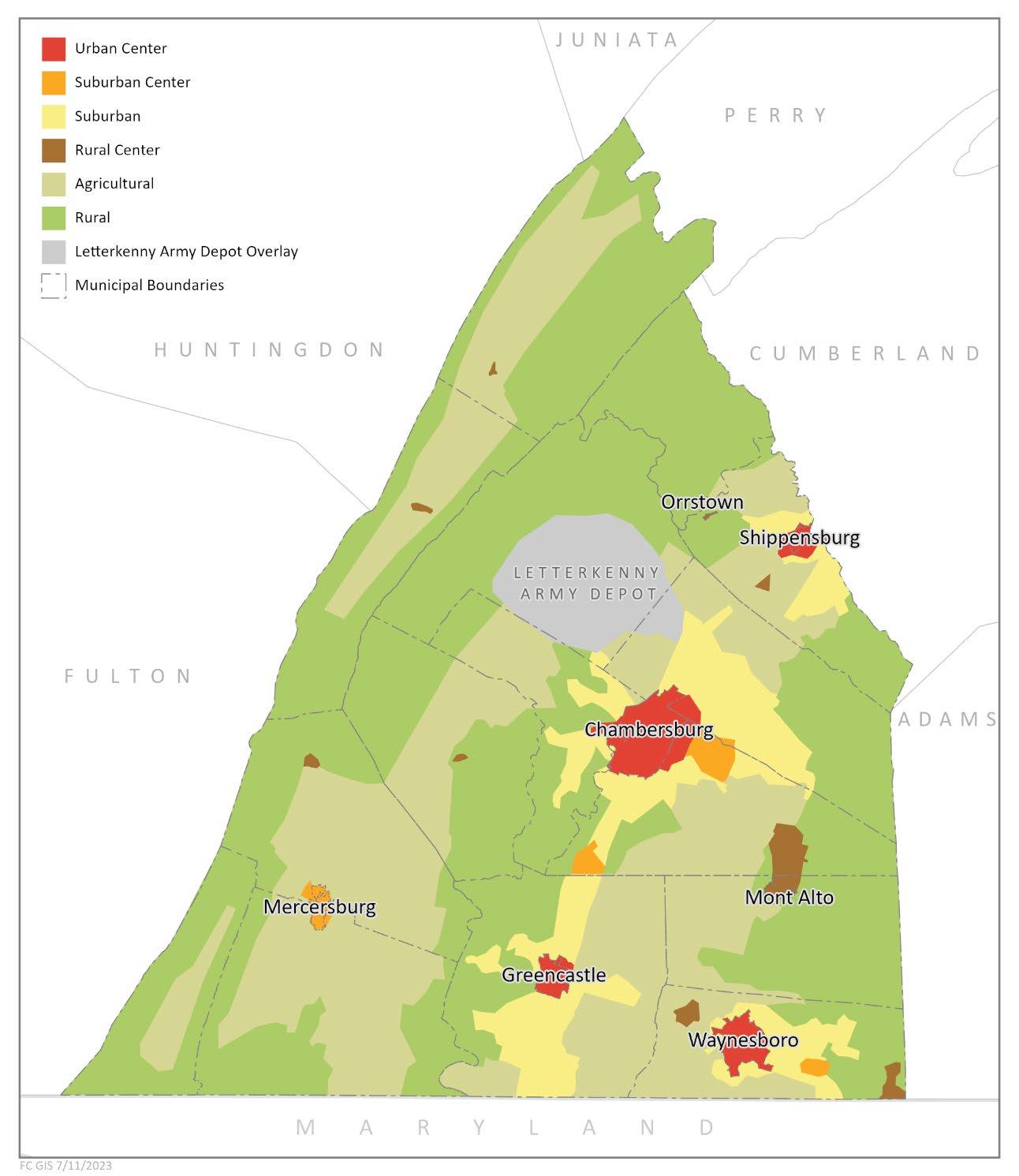
The following recommended actions are designed to help manage land use and development within Franklin County. Recommendations are provided in the form of a new or revised policy, program, or project which will be led by the County or in partnership with local municipalities. Some recommendations overlap and have a positive impact within other Focus Areas.
Support protection of farmlands
Continue funding for purchase of agricultural conservation easements
Leverage other funding resources to increase the investment in farmland preservation
Additional farmland is under a preservation easement
Additional farmland is under a preservation easement
Monitor the impacts of solar and the advancement of agrivoltaic technology that may allow farmers to sustain their operations
Support protection of natural areas
Create a plan that prioritizes preservation of natural areas and the linkage to parks, recreational areas, and prime farmland
Farming and agricultural industry continuing to thrive
• Franklin County Planning Department
• Franklin County Commissioners
• Franklin County Planning Department
• Franklin County Commissioners
• Municipal officials
• Franklin County Farm Bureau
• Franklin County Planning Department
• Franklin County Commissioners
• Municipal officials
• Franklin County Farm Bureau
A clear strategy that prioritizes regionally significant projects to protect and preserve natural areas, recreational opportunities, and open space
Explore opportunities to create a dedicated funding source to support priority conservation projects
Support local policies that advance protection of parks, open space, and critical natural resource protection
Priority areas within the county are preserved for future generations
Priority areas within the county are preserved for future generations
• Franklin County Planning Department
• Municipal officials
• Non-profit entities and conservancies
• Franklin County Planning Department
• Municipal officials
• Non-profit entities and conservancies
• Franklin County Planning Department
• Municipal officials
• Non-profit entities and conservancies
Support projects that conserve open space and promote tourism-related activities
Additional recreational opportunities are established that increase tourism
Promote development patterns consistent with the county’s Character Area Map
Identify tools to promote development around established communities
Support revitalization efforts within boroughs and villages
Advocate for zoning policies that allow for mixed use and higher density housing development within Urban and Suburban Character Areas
Support agricultural economic development through innovative agri-business operations
Ensure Long Range Transportation Planning is aligned with planning policies of Character Areas
Concentric growth patterns are embraced over sprawl
Boroughs and villages are being revitalized
New development within the Urban and Suburban Centers of the county
Business opportunities expanding for farmers that support the agricultural industries
Transportation improvement projects and funding support the Character Area concept throughout the county
• Franklin County Commissioners
• Franklin County Planning Department
• PA Department of Conservation and Natural Resources
• Municipal officials
• Franklin County Planning Department
• Municipal officials
• Franklin County Commissioners
• Franklin County Planning Department
• Franklin County Commissioners
• Municipal officials
• Franklin County Planning Department
• Franklin County Commissioners
• Municipal officials
• Franklin County Area Development Corporation
• Franklin County Farm Bureau
• Franklin County Metropolitan Planning Organization
• Municipal officials
• PennDOT
Quality of Life
• Provide access to quality housing that meets the needs of a growing community
Quality of Growth
• Expand attainable housing options
• Balance growth opportunities that provide housing and business development to support future populations with preservation of the county’s scenic beauty and natural resources
Fluctuating housing prices and increases in demand to live in Franklin County will continue to strain the balance of housing within the county. Due primarily to its rural character and healthy agricultural industry, Franklin County has a lower percentage of land dedicated to attached single family and multiple family uses. Ensuring “missing-middle” housing ownership and quality rental housing options will be necessary as Franklin County continues to grow. Balancing the need for quality housing at all price points with the County’s desire to retain its rural, cultural, and scenic character will be a priority over the next 10 years.
Housing for existing and future residents is becoming a key issue as the community continues to be an attractive place to live, raise a family, and retire. As demand to live in the county continues, ensuring that a balance of quality housing for all levels of households
will be critical. To help understand the housing needs over the next 10 years and assess policies and programs needed to address housing issues, Franklin County partnered with the Shippensburg University Center for Land Use and Sustainability to develop a housing assessment for Franklin County in June 2022. Many of the report’s key recommendations are carried forward and incorporated in Imagine Franklin 2035.
To supplement the Housing Assessment findings, the County utilized a series of community engagement opportunities to further vet the issues most important to residents as part of this planning process. An online survey and input from the Steering Committee provided valuable feedback on housing priorities that is summarized within this section.


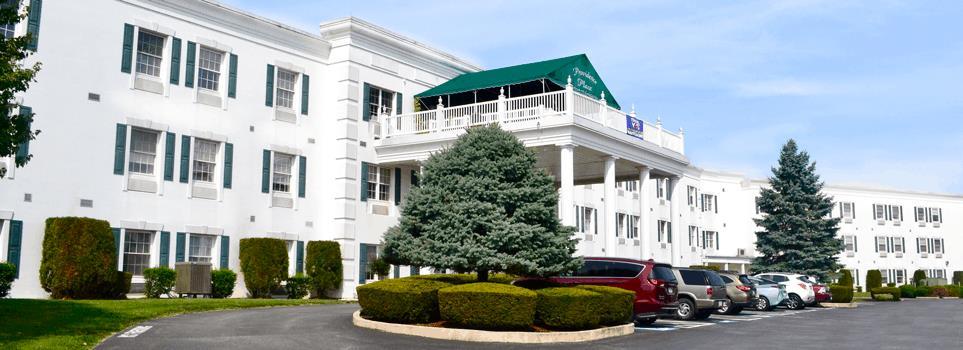

According to the U.S. 2020 Census, Franklin County’s homeownership rate exceeds the statewide average with 71.2% owner-occupied homes compared with 68.9% in Pennsylvania. The county also has more detached single-family dwellings as a percentage of its total housing units than the statewide average, 66.4% compared to 57%. There are also fewer options when it comes to multi-family housing within Franklin County compared to the state (Figure 8).


The median sales price for Franklin County homes increased 29% between 2015 and 2020, from $149,900 to $193,450. Market demand has increased as well, illustrated by the total number of days on the market (135 days in 2015 compared to 57 days by 2020).
The median gross monthly rent was $905 in 2020, up from $809 in 2015. In 2019, 22.8% of all Franklin County households were housing cost-burdened, including 15.3% of owner-occupied households and 44.9% of renter households. Households are considered cost burdened if they pay more than 30% of their income on housing. (U.S. Census 2019 ACS 5-Year Estimates; Harvard University’s Joint Center for Housing Studies)
Franklin County’s 2022 Housing Assessment identified the need for 3,122 new housing units by 2030 (Figure 9). However, this figure was based on population projections and did not consider development constraints, such as land availability or zoning.

Sources: 2020 ACS 5-Year Estimates and the Shippensburg University Center for Land Use and Sustainability
During a six-week period in the fall of 2022, over 1,500 county residents completed an online survey to submit feedback directly related to pressing housing issues, which also allowed the County to gain an understanding of what residents wanted for their community. The following responses related to housing issues were collected.
Survey Question: How important are the following actions to improve housing in Franklin County? *
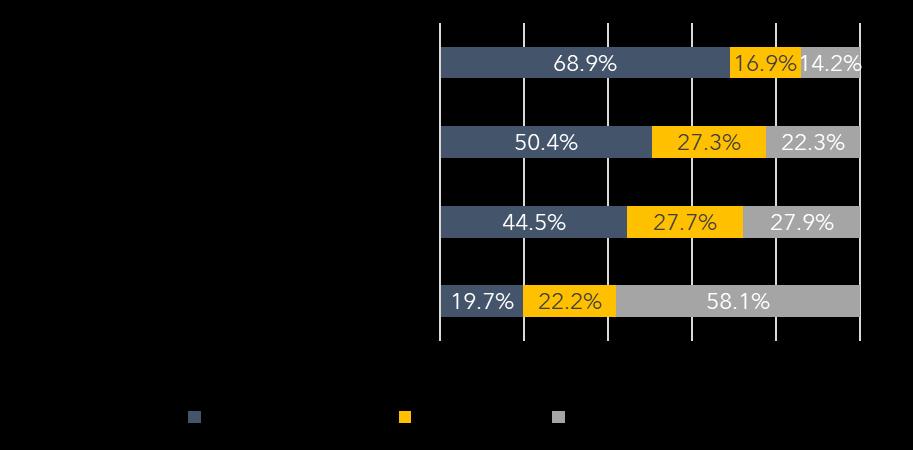
Community members have a strong desire to address the increasing cost of housing, improve the available housing stock, provide housing education for first-time homebuyers, and to increase housing options throughout Franklin County. Respondents noted the biggest issues with housing in the county are overall affordability and the need for more senior housing.
Survey Question: What is the biggest issue with housing in Franklin County?
Answers were solicited using an open comment format. Of the issues identified by respondents, affordability, senior housing, and quality were common themes.
Survey Question: What types of housing are needed in Franklin County?
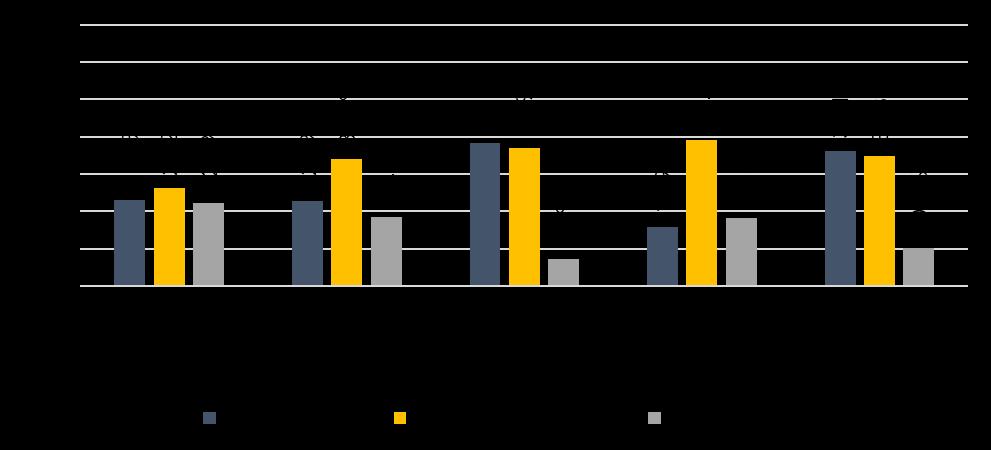
Respondents stated there is a countywide need for all types of housing, including subsidized housing, multi-family, senior, and single-family homes. These responses indicate the need for housing policies and programs that address the full spectrum of housing options throughout the county. Reasonably priced, senior, and “missing-middle” housing planned for areas that are suitable for development will be necessary to help the county keep pace with population growth over the next 10 years.
The following are recommended actions to address gaps in housing. Recommendations are provided in the form of a new or revised policy, program, or project which will be led by the County or in some cases community housing partners.
Create a Local Housing Best Practices Toolkit to assist municipalities and developers in planning and zoning for attainable housing
Promote mixed-use zoning along with design standards within urban centers and where new commercial corridors are planned to ensure that uses are at a compatible scale
Provide model zoning language that helps address nontraditional types of land uses such as accessory dwelling units (mother-in-law suites), inclusionary zoning standards, and short-term rentals
Encourage replacing site design standards that create barriers to attainable housing such as parking minimums for senior housing, suburban-style building setback in urban areas, and low density in developable areas
Conduct a public outreach strategy to inform community members and municipalities on the overall economic benefits of planning for and incentivizing attainable housing models
Develop a Franklin County housing finance guide to help smaller housing developers understand funding available in Franklin County
Provide direct assistance to municipalities through low- or no-cost auditing of local land use policies, including zoning and SALDO
Residents are supporting more housing options
Municipalities are updating their zoning and SALDO to support mixed-use development Franklin County Commissioners
Increase housing options throughout the county
Flexible development standards added to local ordinances
Franklin County Planning Department
Municipal officials
Franklin County Planning Department
Housing developers
Non-profit developers
Municipal officials
Franklin County Planning Department
Municipal officials
Franklin County Housing Authority
Home prices and rental rates are attainable to more families
Smaller scale and scattered site housing development is increasing
Zoning ordinances and SALDOs are updated to promote housing opportunities
Franklin County Housing Authority
Non-profit housing agencies
County residents
Pennsylvania Housing Finance Agency
Franklin County Area Development Corporation
Municipal officials
Zoning officers
Borough and township associations
Expand tools and resources that will support the goals of Imagine Franklin 2035, particularly in instances where Urban Centers are impacted.
Consider adoption of Act 152 of 2016, which would allow the County to create a Demolition Fund to provide funding for removal of blighted properties that can be used for redevelopment projects. This would be particularly helpful within boroughs and villages.
Promote the Neighborhood Assistance Program (NAP) and Neighborhood Partnership Program (NPP) throughout the county as a way to bring in resources to address community issues, including housing
Promote the use of Local Economic Revitalization Tax Assistance (LERTA) in areas for preferred redevelopment
Host coordination meetings and legislative briefings with municipalities/boroughs to address needs and concerns of the county
Work with local legislators to advance housing finance to assist with funding the gap between Pennsylvania Housing Finance Agency’s PA Housing Affordability and Rehabilitation Enhancement (PHARE) Fund and Community Revitalization Fund Program (CRFP) for smaller projects consisting of 9-15 units
Redevelopment opportunities are expanded within urban centers
Franklin County Area Development Corporation
Franklin County Housing Authority
Franklin County Commissioners
More funding is being generated for community development initiatives
Franklin County Commissioners
Franklin County Planning Department
PA Department of Community & Economic Development
Redevelopment in aging commercial and residential areas Franklin County Commissioners Municipal officials
Franklin County school districts
Greater collaboration among local government and legislative policy is advancing
Franklin County Commissioners
Municipal officials
More housing stock is being added to meet the needs of Franklin County’s population at all levels Franklin County Commissioners
Pennsylvania Housing Finance Agency
Franklin County Housing Authority
Promote multi-municipal and regional planning and zoning that supports a fair, coordinated distribution of housing choices across the county Provide planning support for municipalities to prepare multimunicipal plans with the goal of balanced distribution of land uses, including housing types
Offer technical support, such as grant writing assistance or administrative support, and assist with Request for Proposals (RFP) development
Multi-municipal cooperation is increasing
Multi-municipal zoning is being implemented
More municipalities are receiving grants to assist with planning efforts
Franklin County Commissioners
Municipal officials
Franklin County Commissioners
Municipal officials
Quality of Growth
• Strengthen opportunities to grow our workforce and educational assets
Workforce shortages across Franklin County limit employers’ ability to fill open jobs, both now and into the future. While the county has a focused, engaged network of professionals actively addressing workforce and education barriers, more can be done to support those efforts. Barriers limit the future earning potential of both employees and employers. Additional strategies benefiting employees and employers will ensure the county has the trained workforce required to sustain its high quality of life in the future.
Workforce Shortages
Workforce shortages exist throughout the country. Whether healthcare, manufacturing, warehousing, agriculture, or emergency services, public and private employers face challenges retaining and attracting new employees. Nationally, this trend is driven by three demographic factors, each of which has been exacerbated by the COVID-19 pandemic (Demographic Drought, Emsi, 2021).
Departure of Older Workers – Baby Boomers born between 1946 and 1964 are the largest demographic group in the nation’s history and are continuing to retire in significant numbers. On average 2,000,000 leave the workforce each year. The departure of this large group of workers leaves
employers with gaps in key positions as well as experience. With life expectancy increasing, retired Baby Boomers will be dependent upon younger generations for support for a longer period of time.
Record-Low Labor Force Participation Rate – While an older generation continues to retire, younger generations are not fully participating in the workforce. An increasing number of people of prime working age, between 25 and 54, have voluntarily opted out of the workforce. Many factors influence low workforce participation, but in recent years the COVID-19 pandemic has had a substantial impact on a person’s ability to work. For younger families not participating in the workforce, lack of childcare is often a barrier.
Low Birth Rates – The nation’s birth rate began declining in the 1970s and reached a 35-year low in 2019. Lower birth rates mean that over the next few decades the future workforce available to fill jobs will continue to decrease, further impacting workforce shortages.
In general, Franklin County is experiencing the same workforce trends as the nation as a whole. The county’s population continues to age in place. In 2020 there were 9,820 more people aged 55+ in Franklin County than in 2010. The county has 1,424 fewer people under 54 years old than it did in 2010. While there were gains in a few age groups, the county has fewer children, teenagers, and prime working-age adults.

Source: 2020 ACS 5-Year Estimates
The county’s labor force participation by age group – those people in the workforce for each age range – mirrors that of Pennsylvania. Labor force participation is high for each age group and the participation of Franklin County’s workers aged 16 to 29 exceeds that of the state.

Source: Pennsylvania Department of Labor and Industry, Center for Workforce Information & Analysis, County Statistics Dashboard. https://www.workstats.dli.pa.gov/dashboards/Pages/CountyStats.aspx .
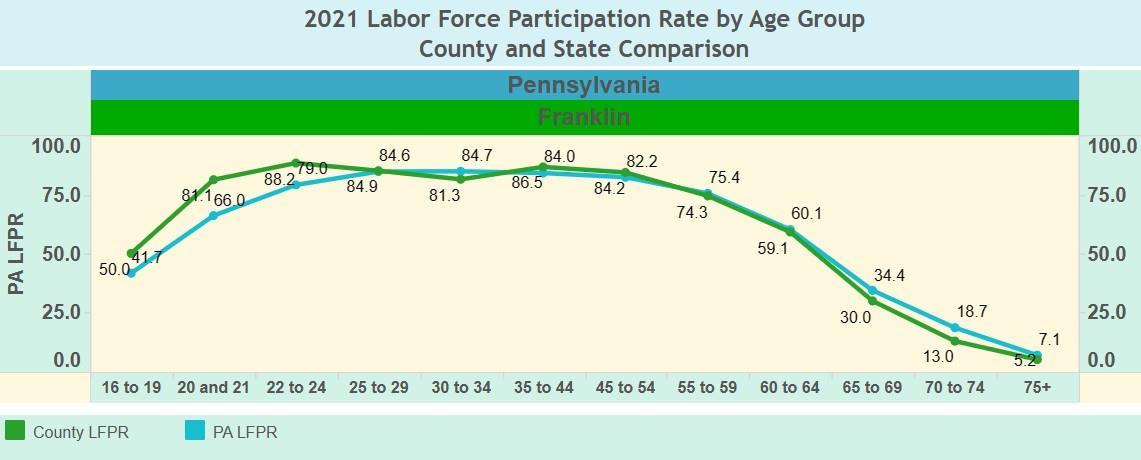
Source: Pennsylvania Department of Labor and Industry, Center for Workforce Information & Analysis, County Statistics Dashboard. https://www.workstats.dli.pa.gov/dashboards/Pages/CountyStats.aspx .
Like the nation, Franklin County’s birth rate is trending downward. Between 2010 and 2020, while the rate of natural increase (births minus deaths) was positive with 2,633 more births than deaths, the number is falling. Natural increase was 578 in 2010, dropping to 160 in 2019 and negative in 2020, likely due to the COVID-19 pandemic.





















Source: PA Department of Health, Division of Health Informatics, Births and Deaths by County, Annual 2010 to 2020.
While 30% of Franklin County’s population increase between 2010 and 2020 was due to natural increase, the remainder was due to migration. Migration to Franklin County was primarily from other Pennsylvania counties and other states. Younger age groups, between 5 and 29 years, represented more than 45% of the migration into Franklin County.


30
Source: U.S. Census ACS 5-Year Estimates. Table B07001 Geographical Mobility (2010 and 2020).
While the number of people moving into the county is not a significant portion of total population, efforts to retain these citizens with housing and job opportunities will ensure they continue to live in the county and contribute to the county’s growth. The portion of the county’s migration from abroad is small but does impact the level of community services required, depending on the country of origin. Franklin County’s workforce is composed of mostly existing residents and/or new residents moving into the county through migration. Strategies to retain and train both are critical.
Franklin County has a diverse employment base led by health care, manufacturing, and transportation and warehouse employers.

Source: PA Work Stats
All industries in Franklin County are under pressure to find new workers. According to job posting information published by the Pennsylvania Center for Workforce Information & Analysis (CWIA), health care workers are the most sought after by employers in the south central workforce development region (PA CWIA, January 2023). Finding trained, credentialed health care workers is a
nationwide need and one which has been even more critical since the COVID-19 pandemic.
Transportation and warehousing workers are also needed to keep pace with the substantial growth of the logistics industry. Franklin County’s prime location within the Mid-Atlantic region, access via Interstate 81, and two intermodal facilities are driving more warehouse construction. With 13 million square feet under construction or planned in Franklin County and an estimated 500 jobs per million square feet, an estimated 6,500 new warehouse workers will be needed in the county over the next few years, according to the Franklin County Area Development Corporation (FCADC, March 2023).
According to the county’s workforce partners, there are several barriers that hinder employers in filling open positions.
Understanding the priorities and concerns of potential employees who are not currently working and addressing those priorities and concerns will improve the ability of Franklin County employers to hire, retain, and grow. Each of these barriers was noted as an issue during the stakeholder and public outreach conducted for the comprehensive plan.
Housing – When new workers find a job in Franklin County, they increasingly need to travel greater distances to work because there are not enough housing choices. If housing is available, it is not affordable for some employees. Due to lack of housing and/or a lack of housing within the employee’s means, some residents reported a one-way commute time of over an hour. This is documented by an increase in the amount of time it takes Franklin County employees to travel to work, according to the U.S. Census. The average travel time to work was 23.3 minutes in 2010 and increased to 24.7 minutes in 2020 (U.S. Census ACS 5Year Estimates, 2010, 2020). Additionally, housing is often
a barrier for foreign-born workers employed by county farmers. In addition, constraints associated with work visas are burdensome for some workers and farmers.
Childcare – Families raising children often struggle with finding affordable daycare that is conveniently located to work or home. Even if affordable, conveniently located daycare is available, the daycare’s operating hours sometimes do not fit with work schedules. Some families are getting by on one income, with a family member staying out of the workforce because the cost of childcare is too expensive or not available. Addressing childcare constraints will help pull people back into the workforce.
Job Training and Education – Both the cost of job training for students and limited availability of instructors to teach training courses are trends occurring in Franklin County. The healthcare industry is particularly impacted by a lack of educators as well as clinical space for hands-on training. While scholarships and funding are available, educational dollars are limited: some prospective students do not have the financial resources available to meet tuition costs. In addition, maintaining modern, up-to-date training facilities and increasing the amount of training space available to meet current and future training needs is also required to address the county’s job training and education barriers.
Transportation – Many workers lack transportation to get to and from work. Some families rely on one vehicle, and a few have no vehicle. In general, Franklin County workers are better off than Pennsylvania workers. Only 2.1% of Franklin County workers did not have access to a vehicle compared to 5.0% of all Pennsylvania workers (U.S. Census ACS 5-Year Estimates, 2020). Addressing the barriers impacting how employees get to and from work will ensure that employees
receive paychecks and employers meet their operational goals, whether the employer is in the private or public sector.
Franklin County Workforce and Education Network
Franklin County has an existing, well-defined network of partners continually working together to address the workforce and education barriers noted above. The network provides programs and services, identifies barriers, and develops solutions for employers, employees, and students. The benefit of the county’s workforce and education network is that an existing/prospective employer, worker, or student can contact any one of the partners in the county’s network for assistance – there is no wrong door to finding assistance in Franklin County. If the contacted partner does not provide services needed, the partner will forward the request along to the appropriate colleague who can. The partners work to address new challenges or barriers.

Adult Job Matching & Referrals
PA CareerLink® Franklin County

Business Expansion/Attraction
Franklin County Area
Development Corporation (FCADC)
ChambersburgAreaDevelopment Corporation (CADC)
Community-Based Support
AHEDD
United Way of Franklin County OccupationalServices,Inc.(OSI)
Keystone Human Services
LIU 12 Franklin County Adult Learning Center
Early Childhood Education
United WayofFranklin County
First Start Partnerships for Children and Families
SouthCentralCommunity Action Programs (SCCAP)
English as a Second Language (ESL)
Agape Ministriesat KingStreet Community Center
FirstStartPartnershipsfor Children and Families
Franklin County Literacy Council
PA CareerLink® Franklin County
Post-Secondary

Education/Workforce Training
Franklin County Career & Technology Center
Triangle Tech
SCPa Works
PACareerLink®FranklinCounty
Penn State Mont Alto
Shippensburg University
Wilson College
Secondary Education
FranklinCountyCareer& Technology Center
Triangle Tech
ChambersburgAreaSchool District
Fannett-MetalSchoolDistrict
Greencastle-Antrim School District
Shippensburg AreaSchoolDistrict
Tuscarora Area School District
Waynesboro Area School District
Addressing workforce shortages requires understanding what the county’s employers need to remain competitive. This often means developing new programs to fill training gaps. The following are recent examples of the county’s workforce and education network implementing solutions to address workforce needs.
Healthcare – Several county-level programs are designed to meet the increasing need for health care workers:
o In 2022, Penn State Mont Alto opened a $13 million Allied Health building for educating nurses and occupational and physical therapy assistants.
o Wilson College bachelor’s degree nursing program, in place for 10 years, currently has 100 students enrolled. Wilson College is also developing a graduate program in speech language pathology and two doctorate programs in occupational therapy and physical therapy.
o In 2020, Franklin County Career and Technology Center (FCCTC) completed a new allied health training facility, providing space to train certified nursing assistants (CNAs) and licensed practical nurses (LPNs).
o WellSpan Health, in partnership with Wilson College and FCCTC, will establish a surgical technologist program in 2024 to address a critical shortage at WellSpan Chambersburg.
Logistics/Warehousing – Responding tolocal employer needs, Wilson College developed a four-year degree program in supply chain management.
Unemployed and Under-Employed – The Stepping Forward Works program, developed by United Way, connects the unemployed and under-employed to high-priority occupations through industry-certified training, essential skills development, and job search assistance.
Online Learning for Full-Time Employees – Shippensburg University, Wilson College, and Penn State Mont Alto developed online learning opportunities to meet the needs of full-time employees working towards associate and bachelor’s degrees. Wilson College Online provides asynchronous learning for nine bachelor’s degree programs.
Customized Workforce Training – Shippensburg University’s Office of Workforce Development (OWD) provides customized, professional workforce development programs meeting employer needs. Working with the Workforce and Economic Development Network of Pennsylvania(WEDnetPA), Commonwealth trainingfunds can be accessed to improve worker skills and productivity.
While Franklin County’s workforce and education network actively addresses barriers, other opportunities exist. The following recommended actions address barriers identified by the network.
Improve the delivery of workforce training and worker availability by addressing regulatory, licensing, and funding burdens that create obstacles for businesses, employees, schools, and students.
Work with state and federal legislators to address regulatory and financial obstacles faced by technical schools, such as Franklin County Career & Technology Center (FCCTC) and Triangle Tech, and students pursuing certifications through their programs
Continue to deliver high-quality career and technical training now and in the future
Franklin County Commissioners
Federal and state legislative delegation
Franklin County Career & Technology Center
Triangle Tech
PA Department of State
PA Department of Health
SCPa Works
Assess state legislation regarding cyber education to minimize the impact of private cyber schools on school district funding
Increase the amount of school district funding available for traditional public education
Address employment barriers associated with the U.S. Department of Homeland Security, U.S. Citizenship and Immigration Services H-2A Temporary Agricultural Workers program through collaboration with legislators Workers are available throughout the year to meet the production needs of Franklin County farms
Franklin County Commissioners
State legislative delegation
Franklin County school districts
Franklin County Commissioners
Federal and state legislative delegation
Franklin County agriculture employers
Attract and retain employees by developing agile organizations as well as private and public sector employers that balance the needs of different types of workers and employers to find common ground and maximize positive outcomes for both.
Younger Generations & Retirees – Support work-life balance solutions to meet the preferences of younger generations and employees, such as flexible work schedules, remote work opportunities, and part-time work
Increase Franklin County’s labor participation rate and meet employer needs
Franklin County employers
SCPa Works
Franklin County Area Development Corporation
Chambersburg Area Development Corporation
Citizens Re-Entering the Workforce – Address training and workplace barriers impacting citizens who are re-entering the workforce after a long absence or who were formerly in the criminal justice system
Succession Planning – As older workers (age 55+) are nearing retirement, ensure that skill sets and institutional knowledge are cataloged by employers and passed on to younger employees
Increase Franklin County’s labor participation rate and meet employer needs
Shippensburg University Small Business Development Center
Franklin County employers
SCPa Works
Franklin County Area Development Corporation
Chambersburg Area Development Corporation
Shippensburg University Small Business Development Center
Improve business continuity, reducing economic disruption
Franklin County employers
SCPa Works
Franklin County Area Development Corporation
Chambersburg Area Development Corporation
Shippensburg University Small Business Development Center
Confront the childcare and transportation barriers that hinder workforce participation of working families, low-income citizens, and citizens with disabilities.
Develop an employer-supported initiative to create long-term solutions that address childcare and transportation
Permanently improve access to affordable, convenient childcare and transportation for Franklin County residents
Franklin County employers
SCPa Works
Franklin County Area Development Corporation
Franklin County Metropolitan Planning Organization
PA Department of Community & Economic Development
PA Department of Labor & Industry
Provide housing options to meet the needs of Franklin County’s current and future workforce.
Develop a municipal- and employer-supported initiative to work with housing developers to increase housing at strategic locations in Franklin County
Provide housing to meet the needs of citizens of all income levels and the short-term housing needs of foreign-born workers
PA Department of Human Services
Municipal officials
Franklin County employers
Franklin County Housing Authority
Luminest Community Development
Pennsylvania Housing Finance Agency
Pen-Mar Regional Association of Realtors
Quality of Place
• Create a strong sense of place within our historic urban centers by activating underutilized and vacant spaces and supporting economic vitality
Quality of Life
• Provide community facilities in concert with our approach to future growth
Quality of Growth
• Strengthen opportunities to grow our workforce and educational assets
• Balance growth opportunities that provide housing and business development to support future populations with preservation of the county’s scenic beauty and natural resources
The population of Franklin County increased over the last few decades. Although most rural counties experienced population loss, Franklin County and its neighboring counties grew in population. Franklin County’s growth includes increases in the populations of the Borough of Chambersburg and surrounding municipalities.
Demand for community services increases with the county’s population. New and expanding households need basic services such as water, sewer, public safety, transportation, recreational opportunities, broadband and similar services. The County, municipalities and utility agencies must be prepared to meet those demands through proper planning and extension of services to areas deemed appropriate for growth.

There are 22 municipalities within Franklin County and each local government, municipal authority, and the County all have specific roles and responsibilities to provide needed services. The Franklin County Board of Commissioners has specific duties to administer or support voter services, human services, judicial services, emergency services, and correctional services. In addition, the commissioners are responsible for the planning and coordination of transportation, including county-owned bridges, and land use as well as associated planning areas. Municipalities have a more direct impact on land development driven by zoning and subdivision regulations, while local authorities are organized to manage water and sewer service areas. All of these entities need to collaborate in order to ensure that growth and development are occurring at a rate where local capacity is able to support new households and in areas most suitable for new development or redevelopment of historic communities.


During a six-week period in the fall of 2022, residents had the opportunity to complete an online survey to provide feedback on their most pressing issues, which also allowed the County to gain an understanding of what residents wanted for their community. The survey resulted in over 1,500 responses, many of which were directly related to community services and are highlighted below.
Survey Question: How satisfied are you with the following services throughout the County? Only 46.5% said they were very to somewhat satisfied with recycling services, 64% were satisfied with internet and broadband and over 77% were satisfied with water and sewer service.

Recycling services received the highest number of responses by residents who indicated dissatisfaction with the level of service provided. Recycling is available through drop-off sites provided by municipalities and through private businesses. Residents may also contract with waste haulers to dispose of recyclable materials. The County has collected information on municipal-owned and privately owned drop-off facilities and provides their location through an online, interactive map. Unfortunately, during public meetings, many residents were still unaware of the drop-off sites. To view recycling availability in Franklin County, visit https://fcgis.franklincountypa.gov/recycling/.
There are many benefits to participating in recycling efforts, including environmental, economic, and community benefits. Community benefits include supporting American manufacturing, conserving valuable resources, and the creation of jobs in recycling and U.S. manufacturing industries. Efforts to promote recycling and locate appropriate facilities need further review. Franklin County’s Municipal Solid Waste Plan, completed in 2013, is due for an update. An update to this plan could help realize specific areas of improvement among all of Franklin County’s recycling partners.
Overall, 64% of residents who took the Imagine Franklin 2035 survey indicated they are satisfied with broadband access. However, due to the rural nature of Franklin County’s landscape, there are certain critical gaps in broadband coverage. The federal Infrastructure Investment and Jobs Act (IIJA) can assist communities throughout the United States in filling those gaps. According to the U.S. Department of Commerce, IIJA has “allocated $65 billion to expand broadband in communities across the U.S., create more lowcost broadband service options, subsidize the cost of service for lowincome households, and provides funding to address the digital equity and inclusion needs in our communities.”
Broadband access is a necessity for people to work remotely and for students to attend virtual classrooms.
Broadband access in Franklin County is currently being assessed through the Franklin and Adams Broadband Feasibility Study. The study elements can be found here Broadband | GIS Department (franklincountypa.gov)
Park and Recreation System
From the Imagine Franklin 2035 survey, 60.7% of respondents indicated that natural beauty and outdoor recreation are what make Franklin County a great place to live, work, learn, and play.
Parks and recreation programs are provided throughout the county by state, federal, and local public and private entities. There are numerous opportunities for residents to explore the outdoors and enjoy the rural setting of the county. However, according to the 2018-2019 Community Health Needs Assessment, only 20% of Franklin County residents meet the national physical activity guideline. The guideline recommends moving for at least 150 minutes each week. In 2019, the Healthy Franklin County Nutrition, Physical Activity and Weight Status Task Force partnered with Franklin County government to create the Franklin County Recreational Facilities map in an effort to better publicize the opportunities for physical activity in the community. To explore the map, visit https://gis.franklincountypa.gov/recreation/.
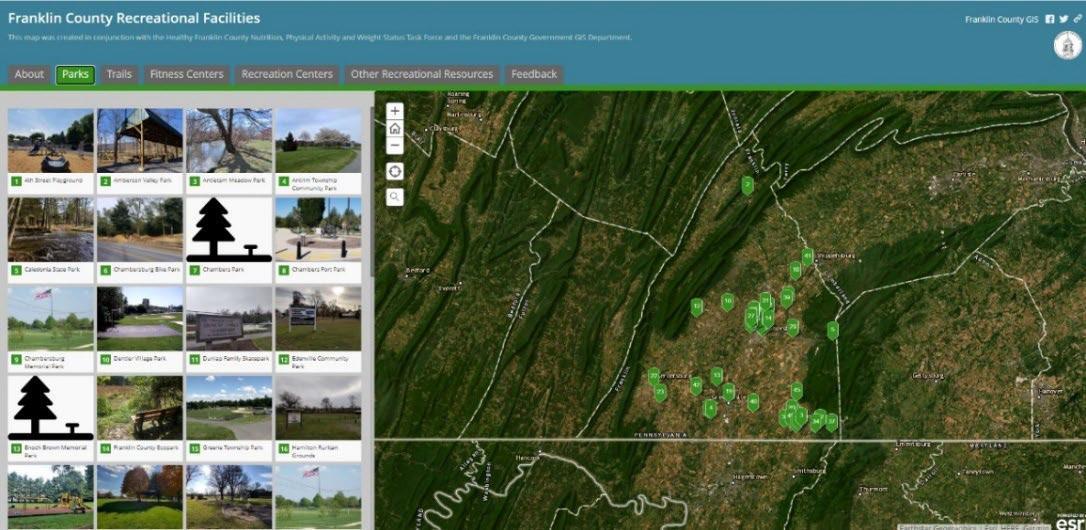
Outdoor recreation opportunities are economic drivers with many millennials placing a value on time spent outside. COVID-19 also led to a significant increase in the utilization of recreation facilities. According to a study led by the Penn State Department of Recreation, Park, and Tourism Management, results have shown that there has been a 20% increase in outdoor recreation across the U.S. both during and after the pandemic.

Finding ways to reduce our environmental impact is essential to ensuring a sustainable future. Pennsylvania’s greenhouse gas emissions are largely the result of electricity generation, transportation, and industrial fuel use. Due to the orientation of Franklin County and the transportation facilities that pass through the area, there are opportunities to contribute to the statewide goals of reducing emissions.
As outlined in Pennsylvania’s National Electric Vehicle Infrastructure (NEVI) plan, developed by PennDOT, both I-76 and I81 are consideredpriority Alternative Fuels Corridors (AFC), which elevates the deployment of federally compliant electric vehicle charging stations. There is also a significant interest in solar field development within the county that should be balanced with the farmland preservation goals of the community.



A recurring theme among the open house events as well as the survey results was the request for more assistance in emergency management planning. According to the Franklin County Department of Emergency Services Strategic Plan, 2020-20251 , the mission of the Franklin County Department of Emergency Services (FCDES) is to “ provide effective services, coordination, and collaboration to create a culture of preparedness that builds and sustains a disaster-resistant and resilient community in Franklin County.”
One of the most frequently mentioned comments during the planning process at public meetings was the need for more first responders to support the county and its residents. As in many sectors, staffing for emergency medical professionals has been a challenge as well. This challenge, among others experienced by local emergency service organizations, led the Franklin County Emergency Services Alliance to conduct a study in 2020. The study provides recommendations to improve the availability and quality of emergency services in the county. At the same time, the Franklin County Department of Emergency Services developed a five-year strategic plan to outline the department’s role in continuing safe and efficient daily operations as well as preparedness for emergency events. Figure 25 identifies some of the goals and measures of success from the recently completed strategic plan.


1https://franklincountypa.gov/ckeditorfiles/files/Emergency-Services/FINAL%20Strategic%20Plan_Feb%202020.pdf
The following are recommended to address needs identified within the focus area of community facilities. Recommendations are provided in the form of a new or revised policy, program, or project which will be led by the County or in some cases local municipal authorities.
Broaden and publicize recycling opportunities
Update the County’s Municipal Solid Waste Plan
Explore the feasibility of hosting recycling and waste collection events on a recurring basis
Additional opportunities promote recycling throughout the county’s 22 municipalities
Instances of recycling are increasing throughout the county
Franklin County Planning Department
Municipal officials
Department of Environmental Protection technical assistance program
Franklin County Planning Department
Municipal officials
Promote recycling through youth educational workshops with schools and environmental clubs
Students throughout the county become environmental ambassadors
Support the Adams and Franklin County Broadband Study outcomes
Provide support to the Adams and Franklin County Broadband Study implementation goals Broadband | GIS Department (franklincountypa.gov)
Increased access to broadband coverage across the county
Promote and encourage outdoor recreation and park system development
Regularly publicize the mapping application to share opportunities that the public can utilize for outdoor recreation
Update the Greenway and Open Space Plan to prioritize projects of a regional significance
Offer support to municipalities to develop additional recreation opportunities
Prioritize implementation of the Cumberland Valley Rail Trail (CVRT) Feasibility Study
Increased physical activity and public facility utilization
Coordinate preservation efforts throughout the county
Increased access to physical activity opportunities
Increased recreational trail use by county residents
Franklin County school districts
Franklin County Commissioners
Franklin County Area Development Corporation
Municipal officials
Telecommunications companies
Franklin County GIS Department
Franklin County Commissioners
Franklin County Planning Department
Franklin County Commissioners
Franklin County Planning Department
Municipal officials
Cumberland Valley Rail-to-Trails Council
Balanced approach to renewable energy development
Explore benefits and impacts of electric vehicle charging stations along transportation corridors
A reduction in greenhouse gas emissions
Franklin County Commissioners
Municipal officials
Railroad companies
Healthcare organizations
Franklin County Area Development Corporation
Franklin County Metropolitan Planning Organization
Pennsylvania Department of Transportation
Continue exploration of benefits and impacts of solar farm development
A reduction in the usage of traditional energy resources
Support implementation of Franklin County’s Emergency Management Plan
Organize and train a professional workforce to be responsive, efficient, and effective in protecting the lives and property of the citizens of Franklin County
A wider base of staffing for emergency service personnel
Franklin County Commissioners
Develop and execute a robust public outreach and training program to inform, educate, and partner with stakeholders and the general public on emergency preparedness and safety with respect to the all-hazard threats in the county
Increased public understanding of what is needed during a county emergency
Franklin County Commissioners
Franklin County Department of Emergency Services
Local emergency management services and fire departments
Municipal officials
Franklin County Public Safety Training Center
Franklin County Commissioners
Franklin County Department of Emergency Services
Local emergency management services and fire departments
Municipal officials
Franklin County Public Safety Training Center
• Create a strong sense of place within our historic urban centers by activating underutilized and vacant space and supporting economic vitality
Franklin County has a rich history of agriculturally-based communities intertwined among lovely boroughs and villages that are the historical centers of commerce and community gathering for county residents. These urban centers embody the rich and cultural diversity that make Franklin County unique and welcoming to new residents. However, due to aging infrastructure, carrying costs of denser development patterns, changing demographics, and in some cases population decline, these urban centers have challenges that differ greatly from their more rural, municipal counterparts. As the county continues to grow, reinvesting in these areas will be important to maintain economic opportunities and provide various levels of housing options for new and expanding county residents.

Population Growth
Overall, Franklin County’s population grew substantially over the past 30 years and that trend is expected to continue. However, as new residents enter the county, identifying areas appropriate to locate that growth is a primary consideration of the County and Imagine Franklin 2035. Balancing the pressure of growth with the desire to preserve natural and scenic resources and preserve farmland is critical.
The Imagine Franklin Character Area Map (CAM) analysis outlines growth areas. These areas have existing or planned infrastructure such as roads, water, sewer, and other community facilities sufficient to support additional population growth, including all boroughs and villages. Funding, policies, and programs geared specifically to historic urban centers to assist with redevelopment of older buildings and updates to existing homes will help maintain these centers of activity for all residents to enjoy.

During a six-week period in the fall of 2022, residents completed an online survey to submit feedback on their most pressing issues, which also allowed the County to gain an understanding of what residents wanted for their community. The survey resulted in over 1,500 responses, including the following responses related to boroughs and villages.
Survey Question: Where would you like to see new types of businesses and buildings constructed in Franklin County? Respondents indicated they prefer to see small retail stores, office, and medical buildings located within boroughs and villages. Most preferred this type of smaller-scale development occurring in urban centers as opposed to large retail, warehousing, or manufacturing types of uses.

Survey Question: Over the next 10 years, how should the County use its staff, time, and resources to make Franklin County a better place to live, work, learn, and play?
Respondents to the online survey indicated that the fifth highest priority for the County when considering how to use staff, time, and resources is to invest in downtowns with more places to shop, eat,

and stay. Fortunately, there are several programs at the state and national level that assist with investment in urban centers. These programs, as well as County-led programs, are included in the specific recommendations to assist with strengthening the county’s boroughs and villages.




As part of the comprehensive plan, Franklin County held 17 focus group discussions with a wide variety of residents, businesses, and stakeholders. Additional input was collected at pop-up events throughout the county. A large portion of the feedback included identification of cultural downtowns as key assets. Many of the challenges that were noted are directly correlated to historic downtowns and urban centers. Areas such as walkability, growth managed within existing communities, the need for varied housing options, and downtown revitalization were noted as issues that Franklin County needs to address through the comprehensive plan process.


The following are recommended to help strengthen Franklin County’s Urban Centers, which are defined as historic boroughs throughout the county. Recommendations will be provided in the form of a new or revised policy, program, or project which will be led by the County or in partnership with local municipalities. Some recommendations overlap and have a positive impact within other Focus Areas.
Create a Development Best Practices Toolkit to assist municipalities and developers in planning and zoning for context sensitive design
Promote mixed-use zoning along with design standards within urban centers and where new commercial corridors are planned to ensure that uses are at a compatible scale
Provide model zoning language that helps address nontraditional types of land uses such as accessory dwelling units (mother-in-law suites), inclusionary zoning standards, and short-term rentals
Encourage replacing site design standards that create barriers to attainable housing such as parking minimums for senior housing, suburban-style building setback in urban areas, and low density in developable areas
Provide direct assistance to municipalities through low- or no-cost auditing of local land use policies, including zoning and SALDO
Residents are supporting more housing options
Municipalities are updating their zoning and SALDO to support mixed-use development
Increase housing options throughout the county
Flexible development standards added to local ordinances
Franklin County Commissioners
Franklin County Planning Department
Municipal officials
Zoning ordinances and SALDOs are updated to promote housing opportunities
Franklin County Planning Department
Housing developers
Non-profit developers
Municipal officials
Franklin County Planning
Municipal officials
Franklin County Housing Authority
Municipal officials
Zoning officers
Borough and township associations
Expand tools and resources that will support the goals of Imagine Franklin 2035 particularly in instances where municipalities have the most influence
Consider adoption of Act 152 of 2016, which would allow the county to create a Demolition Fund to provide funding for removal of blighted properties that can be used for redevelopment projects and is particularly helpful within urban centers
Redevelopment opportunities are expanded within Urban Centers
Franklin County Area Development Corporation
Franklin County Housing Authority
Franklin County Commissioners
Promote the use of Local Economic Revitalization Tax Assistance (LERTA) in areas for preferred redevelopment
Redevelopment in aging commercial and residential areas
Promote historic preservation resources and support for main street redevelopment
Promote Main Street and Elm Street programs to help bolster traditional downtowns
Support historic preservation efforts at the local level through becoming a Certified Local Government (CLG)
Promote the PA Department of Community & Economic Development Keystone Communities Program, including funding for Main Street, Elm Street, Enterprise Zone Designation, NAP and NPP programs
Downtown areas within boroughs and villages are organized and receiving funding and support
Historic buildings are actively being revitalized and reused
Businesses are expanding and growing within Urban Centers
Franklin County Commissioners
Municipal officials
Franklin County school districts
Pennsylvania Downtown Center
PA Department of Community & Economic Development
Borough officials
PA Department of Community & Economic Development
Borough officials
PA Department of Community & Economic Development
Borough officials
Franklin County Area Development Corporation
Promote multi-municipal and regional planning and zoning that supports a balanced and coordinated distribution of land uses throughout the county
Provide planning support for municipalities to prepare multimunicipal plans with the goal of balanced distribution of land uses
Provide incentives for communities to construct trail and bikeways connecting community assets, schools, parks
Multi-municipal cooperation is increasing Franklin County Commissioners
Municipal officials
More trails and bike facilities are being added throughout the county
Increase health and well-being of residents
Franklin County Metropolitan Planning Organization
Municipal officials
Healthcare organizations
Pennsylvania Department of Health
Franklin County Commissioners
BY ADDRESSING HUMAN SERVICES
Quality of Life
• Support human services that work to help people improve their lives and their livelihood
During Steering Committee deliberation, members voiced concerns for lack of access and understanding of health and human services within the county. Further research indicated that the Franklin County Human Services division provides numerous services and resources to the county to address the unmet needs of individuals and families. However, areas of affordable and quality childcare and access to alternative modes of transportation were identified as an unmet need. Although the Human Services division may play a role in supporting these needs, most are within the purview of other community partners that Franklin County will need to engage with in order to address these issues.
Child Care and Start Strong PA
According to the Start Strong PA website, “Start Strong PA is an initiative of Early Learning PA that works through a statewide collaboration of partners. Start Strong PA aims to support healthy child development, working families, and the economy by increasing access to and affordability of high-quality childcare programs for young children.” Through its research, Start Strong PA has found that the benefits from high-quality childcare are numerous and include:
● increased employment and tax revenue for Pennsylvania,
● increased job retention,
● higher earning potential for families,
● improved math and language ability,
● healthy child development, and
● reduced grade repetition
Start Strong PA’s research indicates that less than half the young children in Pennsylvania are in a high-quality program, while less than a quarter of childcare programs in the state meet high-quality standards. Franklin County’s statistics are more dire than the state average with only 18% of childcare capacity currently meeting highquality standards. In order to support expanding workforce needs and ensure children are ready and able to effectively learn, Franklin County will need to advocate for expanded and high-quality childcare for their growing communities.


According to Franklin County’s Human Services Transportation Plan, updated July 2021 and prepared by the Franklin County Metropolitan Planning Organization, there are four key themes affecting transportation-related services for those in need within the county. These themes included:
• Location/Access to Services - Human services are widespread throughout the county with some located outside of the county. The locations that provide necessary services are not always located in areas that are walkable, bikeable, or easily accessible.
• Hours of Service - Most human services offered operate during normal business hours, which may create conflicts for clients and limit their availability due to work or other commitments.

Lack of Access to Affordable Transit Options: The cost of transportation can be a barrier for some individuals requiring human services. Affordable public transit options are limited by a lack of fixed-route transit service and the general lack of taxis and transportation network companies (TNCs) such as Uber and Lyft.
Wait Times and Flexibility: Demand response trips on transit require advanced scheduling with pick-up and drop-off windows. Appointments, events, or errands may only last for an hour, but clients may have to wait up to an hour for their return trip to arrive. This can create a situation where a one-hour task could require three hours.
These gaps in service can affect not only the quality of life of the people who depend on alternative transportation mobility, but greatly affect the employers and businesses that rely on a readily available workforce who can easily access their places of employment. Franklin County, working through the Franklin County Metropolitan Planning Organization, will continue supporting the implementation of the Coordinated Human Services Transportation Plan to improve access to homes, places of employment, community services, and the like.
The following are recommended to help expand access to needed services including affordable childcare and transportation. Recommendations are provided in the form of a new or revised policy, program, or project which will be led by the County or in partnership with local municipalities. Some recommendations overlap and have a positive impact within other Focus Areas.
Support state and local efforts to expand funding for and improve childcare services throughout the county Host workforce summits with education and training providers, major employers, and childcare service providers to strengthen the connections between each industry
Clear roles and strategies are established to support childcare services
Work with early learning programs to support local efforts that provide early learning initiatives in the community
Adopt recommendations from the A Snapshot of the Rural Early Care and Education Landscape Report prepared by Start Strong PA
Support Franklin County Human Services Division
Continue implementation of the Franklin County Human Services Transportation Plan
Increase in the number of qualified childcare providers and employees
Increase access to affordable, highquality childcare
Franklin County Area Development Corporation
Franklin County Human Services
Childcare providers
Institutions of higher education
Franklin County Commissioners
Community organizations
Franklin County Commissioners
Franklin County Commissioners
State legislators
Childcare providers
Improve access to services for the population served by Franklin County Human Services Division
Continue to support implementation of the Franklin County Human Services Plan
Improve the centralization of information related to local services
Increase in residents attaining needed services and decrease in waitlist for services
Residents have a single point of access to learn of the available community resources for their needs
Franklin County Metropolitan Planning Organization
Franklin County Commissioners
rabbittransit
Franklin County Commissioners
Franklin County Human Services
Franklin County Commissioners
Franklin County Human Services
Community human service organizations
The following 3-Year Implementation Strategy illustrates how Imagine Franklin 2035 will be implemented over the coming years. A three-year horizon was used to develop an implementation strategy to provide the most realistic timeline to achieve successful outcomes given the realities of current staff capacity to launch new programs, funding needed to support new initiatives, and legislative processes needed to move new policies into action. This timeline will also allow the Franklin County Board of Commissioners, Franklin County Planning Department, and stakeholders invested in the plan an opportunity to work on plans, policies, and programs while building consensus on how to measure the success of each action.
The goal of the Imagine Franklin 2035 3-Year Implementation Strategy are actions that lead to real and anticipated outcomes and those outcomes must be measurable, transparent, and tied to the core values of the community. Consistent reflection and check-in activities will be key to driving decisions about the plan into tangible progress for Franklin County and its residents, so creating a process by which progress is monitored is imperative. Implementation of Imagine Franklin 2035 will be reviewed every three years to determine if anticipated outcomes are being achieved and if programs and policies are effective in achieving those outcomes. The Franklin County Board of Commissioners, working in conjunction with the Franklin County Planning Department, will develop a 3-Year Progress Report for the plan and will use this report to assess the effectiveness of policies, programs, and new planning efforts to inform future implementation activities. Actions identified within the Focus Area Policy Reports that were not included in the first 3-Year Implementation Strategy will be considered for inclusion in subsequent cycles of implementation.

There are 62 Actions developed to support the 7 Focus Areas identified through the planning process. Six of the 7 Focus Areas were developed into Policy Reports which provide further information on the issues to be addressed and suggested action items to address those issues. These Policy Reports can be found within the Appendix. The seventh Focus Area, Transportation, is noted but will be addressed through the County’s involvement in the implementation of the Long-Range Transportation Plan adopted in April 2023.
Of the 62 Action items noted within the Policy Reports, 35 have been identified for implementation within the next three years, five are legislative action items that the County will seek to implement, 24 are new or enhancements to existing programs, and six strategies call for sector area planning or further research.
























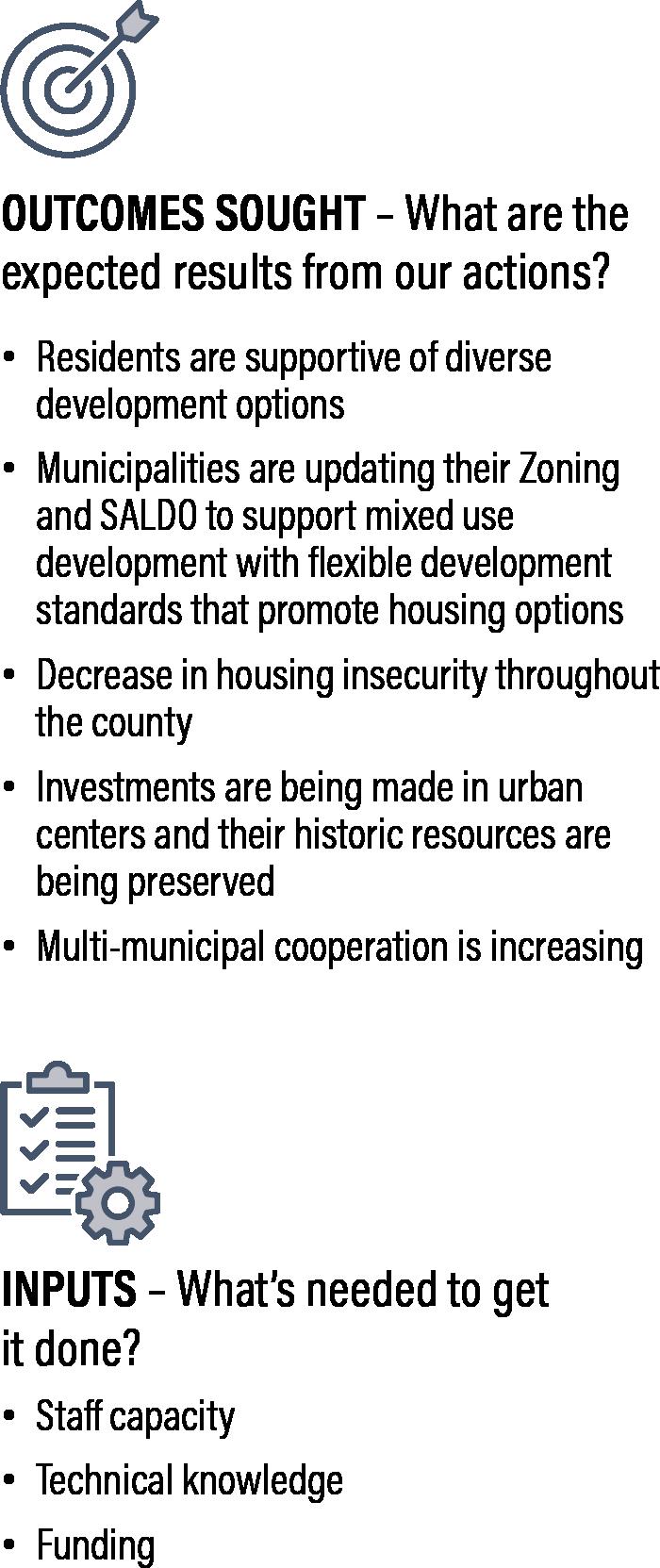







Population
Throughout its history, Franklin County has enjoyed continual population growth decade over decade. Today, the county is home to nearly 156,000 residents. Nationally, the 2020 census demonstrated the American population is urbanizing. This is true in Pennsylvania, where urban counties experienced growth between 2010 and 2020 and many rural counties experienced population loss. Franklin County experienced net growth during this timeframe due to population increases in the Borough of Chambersburg and surrounding municipalities.
Between 2010 and 2020, Franklin County grew by 4.2%, adding 6,314 new residents. However, growth has slowed considerably in comparison to the previous decade where Franklin County grew by 15.7% or 20,305 residents. Franklin County ranks 13th for county growth by percent change in Pennsylvania (2010-2020). Franklin County’s population growth parallels trends in adjacent counties along the I-81 corridor. Cumberland County (PA) grew by 10.2% between 2010 and 2020 and Washington County (MD) grew by 4.9%. Cumberland County is the fastest growing county in Pennsylvania.
Franklin County’s growth is attributable to three primary drivers –longevity (people living longer), natural increase (births), and migration (people moving into the county). Approximately 60% (3,861) of growth between 2010 and 2020 was due to net migration. Antrim, Greene, and Washington townships and Chambersburg Borough all grew by more than 800 residents between 2010 and 2020. Eight municipalities experienced population decline. Montgomery Township experienced the highest net loss, with a decline of 376 residents between 2010-2020. Population projections, prepared by Shippensburg University, estimate similar growth trends through 2030 for the county’s municipalities.

Source: U.S. Census Bureau
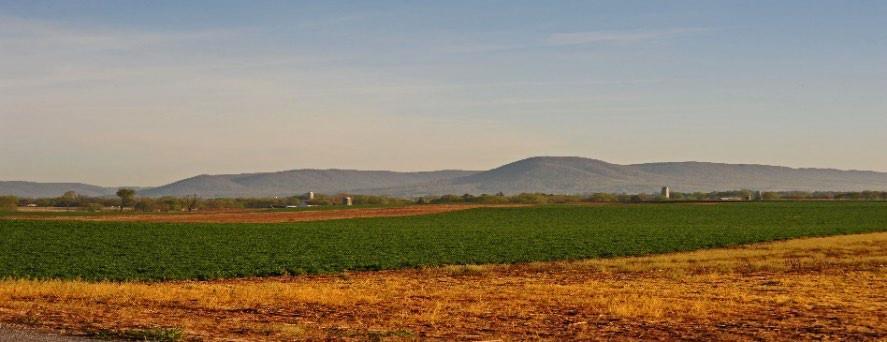
Source: Richard Anderson, Franklin County Photo Contest

Source: American Community Survey 2010, 2020
Franklin County, like the nation, is aging as America’s Baby Boomer generation is in retirement or reaching retirement age. This trend will have implications for housing, workforce development,
transportation, and overall economic resilience for decades to come. The median age in Franklin County is 41.7, compared to the statewide median age of 40.9. There are 9,820 more people aged 55+ in Franklin County today than in 2010. In contrast, the county has 1,424 fewer people aged 0-54. While there were gains in certain age groups, Franklin County overall has fewer children, teenagers, and work-age adults. The county’s boroughs have a younger population than the townships. The median age of Chambersburg residents, for example, is 38.5.
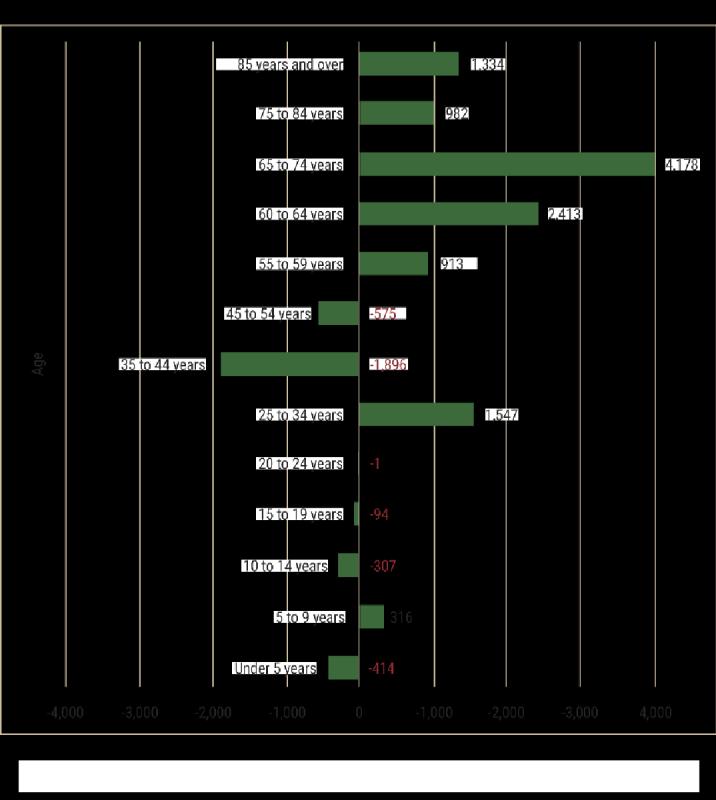

Source: American Community Survey 2010, 2020
Housing
Of Franklin County’s 66,368 housing units, 92% are occupied with 71.2% owner-occupied and 28.8% renter occupied. The county’s owner occupancy rate is higher than the statewide average (68.9%).
Like Cumberland County (PA) to the north and Washington County (MD) to the south, Franklin County’s housing stock is primarily single-family detached units. However, compared to the same counties, Franklin County has a smaller percentage of single-family attached and multifamily options available. The median sales price for Franklin County homes increased 29% between 2015 to 2020, from $149,900 to $193,450. Market demand has been increasing as well, illustrated by the total number of days on the market (135 days in 2015 compared to 57 days by 2020). The median gross monthly rent was $905 in 2020, up from $809 in 2015. In 2019, 22.8% of all Franklin County households were housing cost burdened, including 15.3% of owneroccupied households and 44.9%ofrenter households. Housing is considered cost burdened if a householderpays more than 30% of their income for housing.
Shippensburg University developed housing projections for FranklinCounty and each municipality. Projections were based on population projections and did not consider development constraints such as
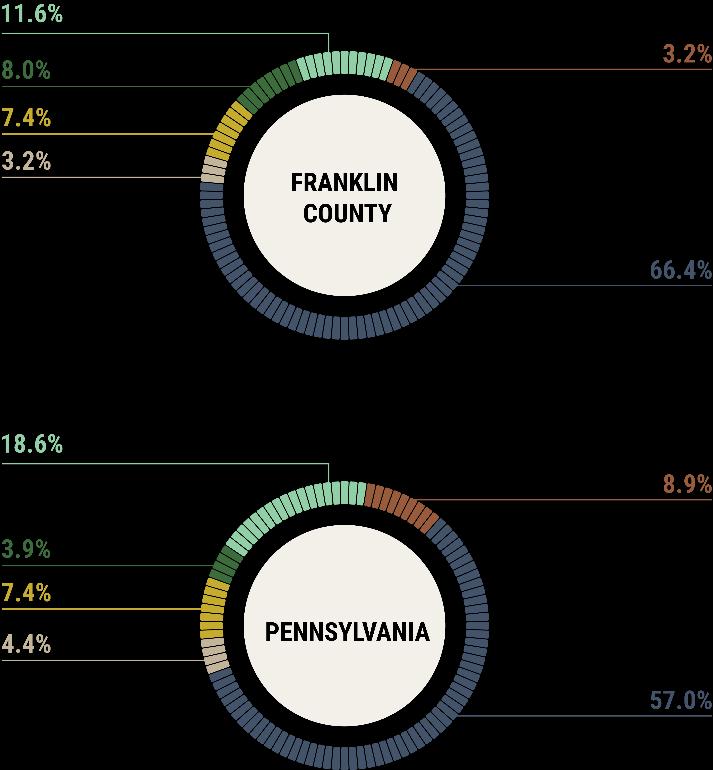
land availability or zoning. The analysis projects Franklin County will need 3,122 new housing units by 2030.

Sources: 2020 ACS 5-Year Estimates and the Shippensburg University Center for Land Use and Sustainability
The U.S. 2020 Census indicates that Franklin County is becoming more diverse. In 2010, 92% of the county’s residents identified as white and in 2020, that number decreased to 86.3%. The county saw a slight increase in African American residents in the past 10 years, up from 3.1% to 3.4% in 2020. And 6.9% of county residents identify as Hispanic. Racial and ethnic diversity is predominately found in the urban communities and Chambersburg is home to nearly half of all Spanish-speaking residents in the county with 47.7% located within this core community.


The median household income in Franklin County is $63,420 according to 2020 estimates. The county’s median household income is higher than the state median of $60,627. Based on income data for the county, approximately 48% of households in Franklin County are considered low income, earning 80% or less of the median family income.


Four key industries provide for 61% of all employment in the county – Health Care and Social Assistance, Manufacturing, Transportation and Warehousing, and Retail Trade. Franklin County’s Transportation and Warehousing and Health Care and Social Assistance industries did not grow as quickly as the state and neighboring counties along I-81. Franklin County’s job growth in Manufacturing and Agriculture, Forestry, Fishing and Hunting outpaced regional and state trends.



Agricultural Preservation
Since 1990, Franklin County has joined the state’s efforts to permanently protect agricultural land through the purchase of easements. As of June 2023, Franklin County has preserved 149 farms totaling 18,719 acres and ranks highly in the state for the number of acres under easement. The Agricultural Conservation Easement Purchase Program is funded with ~80% state dollars and ~20% county dollars and is administered at the county level. Over the past ten years, the County has been able to preserve two to three farms each year with ~$675,000 total in annual funding. In 2022 and 2023, the County selected a total of 19 farms for preservation, thanks to increased investment by the Franklin County Commissioners. Franklin County has ~121 applications on file waiting to be preserved, which is ~10% of the statewide backlog.

Summary of Easements in Pennsylvania, 2021

Source: Pennsylvania Department of Agriculture Annual Report, December 2021
The development and use of large-scale solar installations for community-scale energy generation in the United States is a recent trend. The first large-scale manufacturing plants came online in the early 2000s, and commercial/residential installation became mainstream by the mid-2010s. The use of solar panels has increased in recent years as the cost to install solar panels continues to fall and renewable energy remains a state and federal priority. The first private solar farm was constructed in Franklin County in 2020. Today, the county has six active solar farms and four solar farms proposed or under construction. Planning for the nation’s continued transition to renewable energy while balancing Franklin County’s agricultural lands is a topic that will be explored through Imagine Franklin 2035.
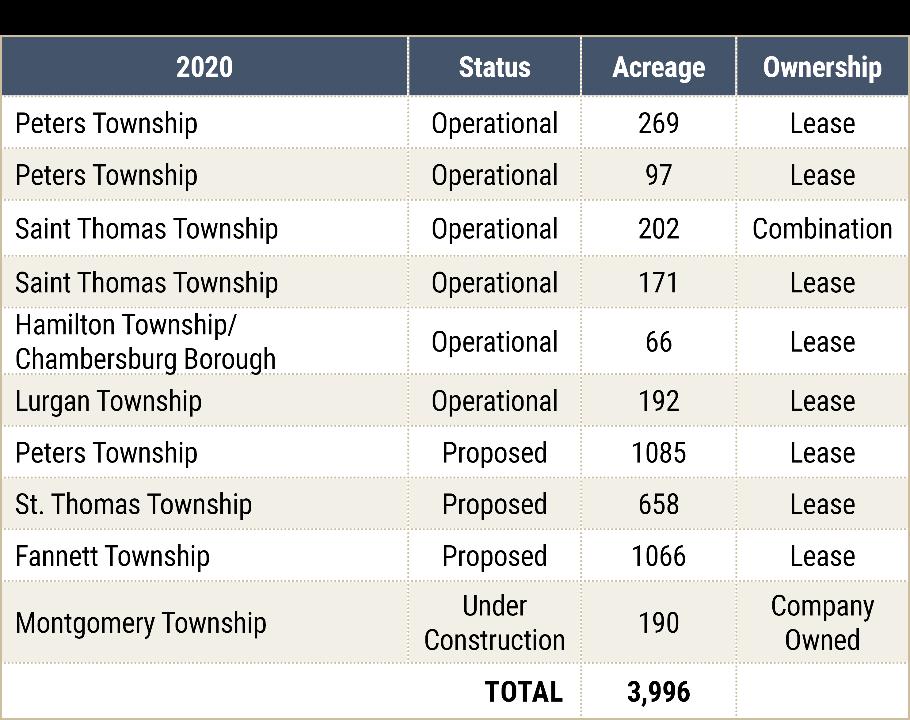
Source: Franklin County Planning Commission

Source: Franklin County Planning Commission
The Franklin CountyMetropolitan Planning Commission (FCMPO) is the official transportation planning organization for the county. The FCMPO coordinates with PennDOT and the county’s municipalities, stakeholders, and the public in planning for the county’s transportation needs.
For the five-year period ending in 2021, Franklin County averaged 1,475 roadway crashes and 18 fatalities per year. Annual crash totals have remained steady since 2010.

Source: Pennsylvania Crash Information Tool (PCIT)
The county has 1,700 linear roadway miles. Interstate 81 constitutes only 25.8 linear miles of roadway yet accommodates 43% of all travel. Data shows 80% of the county’s roadway pavement is in “good” or “excellent” condition, which is consistent with statewide conditions. The county has 323 state-owned bridges and 102 locally owned bridges, including 91 that are fully owned and maintained by Franklin County, and one bridge where the County
shares maintenance responsibilities. The share of “poor” condition local bridges in the county (16%) is less than the statewide average (21.7%).
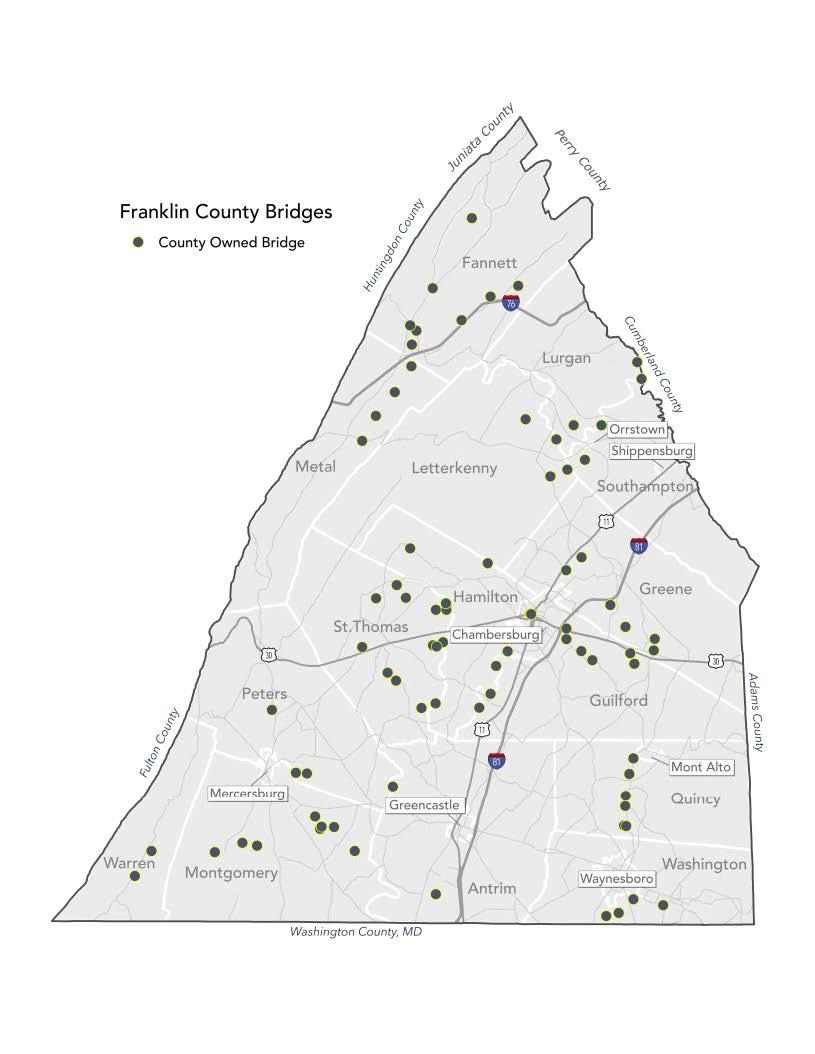

Source: PennDOT

Franklin County currently does not have county-wide fixed route public transit bus service. Paratransit and shared ride services are available through rabbittransit. A three-year micro transit pilot through rabbittransit, known as Stop Hopper, is underway in the Chambersburg area. This bus service aims to help fill gaps in traditional service modes and is powered by a mobile app.


Congestion data reveal that Franklin County experiences 800,000 vehicle hours of delay annually, which translates into lost productivity and increased opportunity costs. There are 121 traffic signals in Franklin County with 40% of them located in Chambersburg Borough. Traffic signals can improve the safety and efficiency of roadway networks for motorists as well as for transit, cyclists, and pedestrians.


Source: RITIS, 2021
The Franklin County MPO updates its regional Transportation Improvement Program (TIP) every two years. The TIP is the listing of priority projects over a four-year period that aims to address safety, congestion, highway/bridge maintenance, bicycle and pedestrian accessibility, and freight-related improvements. The projects are funded through state and federal funding. The MPO’s 2023-2026 TIP was adopted in May 2022. During the next four years, a total investment of nearly $59.2 million will be programmed for transportation improvements. The passage of the federal Infrastructure Investment and Jobs Act (IIJA) in 2021 added an additional $14.59 million to the county’s four-year program, although inflation is eroding buying power. The MPO updated its Long-Range Transportation Plan (LRTP) in April 2023. The plan serves as the blueprint for transportation decision-making as well as the transportation element of Imagine Franklin 2035.


Source: PennDOT
The following resources were also referenced in the Imagine Franklin 2035 –
Franklin County Prosperity Indicators Report –https://growthzonesitesprod.azureedge.net/wp-content/uploads/sites/1322/2019/10/Indicators_Report_from_Chamber_pdf.pdf
Housing Assessment for Franklin County –https://franklincountypa.gov/ckeditorfiles/files/Planning/Franklin%20County%20Housing%20Inventory%20and%20Analysis%20%20FINAL%2006232022.pdf
2022 Community Health Needs Assessment Report –https://www.wellspan.org/media/2729100/2022_CHNA_Report.pdf



Franklin County, under the direction of the Franklin County Planning Department (FCPD and the County) is updating its Comprehensive Plan with a primary focus on tackling key community issues over the next 10 years. This Public Engagement and Communications Work Plan sets forth the steps to inform the public at large about t he importance of the Comprehensive Plan, encourage input, and ensure the planning process is open, equitable, and inclusive. The value of public participation cannot be overstated. Generating substantial public awareness and obtaining the public’s input an d consensus throughout the planning process will ensure the new Comprehensive Plan is position ed for successful implementation .
To maximize public input, this document considers the way citizens consume information and provide input into plan development. The different population segments of the Franklin County community will engage differently with the process for a variety of reasons including time constraints, generational preferences, income, language barriers, and access t o technology. For this reason, the Work Plan provides for a diverse set of engagement techniques and public engagement forums to ensure the planning process reaches citizens across the c ounty, inclusive of all ages, races, genders, income levels, and abilities. The Work Plan includes the following sections:
• Project Team
• Steering Committee
• Public Engagement Events
• Promotion and Online Engagement
Franklin County is diverse. Co mmunity members come from a variety of cultural backgroun ds and ways of life. The Project Team desires to ensure the planning process is promoted/ advertised to all segments of the Franklin County community and provide engagement options that are welcoming and accessible to everyone .
This Public Engagement and Communications Work Plan has been developed to provide a tailored approach to public engagement for the County’s four primary population segmentation groups, identified as follows
Urban
The Boroughs

Suburban
Neighborhoods surrounding the urban communities
Rural
All areas outside the boroughs , predominately the agricultural community and small villages in the northern and southern portions of the county
(note, both print and digital tools will be used for all population segments)
• D igital engagement with Spanish translation
• Pop -up e vent (s )
• Accessible p ublic m eeting(s) in close proximity to population
• D igital engagement
• Talk radio segment
• P rint material (hand -outs at post offices, libraries, firehalls, borough/township offices, coffee shops/ restaurants/ bakeries, etc.)
• Focus groups (typically, only an hour commitment)
As identified by the Project Team and Steering Committee, this includes:
• Low to Moderate Income Households
• Latinx Community
• African American Community
• English as Second Language Community
• Plain Sect Community
• Agricultural Community
• Youth (High School, College, and Young Professionals)
• Focus g roups facilitated with trusted leader (e.g., YMCA serving low-income families, social service organization, church leader, etc.)
• Print material
• D igital engagement (Latinx Community with Spanish translation via Facebook)
• Virtual meeting events
• Direct mailing for rural areas (simple random mailing)
• Direct mailing for low -income census tracts with Spanish translation (simple random mailing)*
Note: Youth will be engaged in a focus group in early September.
*Spanish Translation: The following work products will be translated to Spanish:
• A 1 –2 -page overview of the planning process to be posted on the website.
• The direct mailing postcard to promote public engagement events and the online survey.
• The online survey.
• The Executive Summary of the final Comprehensive Plan.
• Social media posts on Facebook will automatically be translated to Spanish based on a n individual’s Facebook account setting
• At leas t one public engagement event with a Spanish -speaking facilitator available.
The Project Team is led by FCPD with support from a professional consultant team comprised of the following firms :
• Michael Baker International (Lead/Pr ime Consultant)
• Vernon Land Use, LLC (Sub -Consultant)
• Faces International (Sub -Consultant)
The primary staff members for the Project Team are listed below.
Franklin County Planning Department
Franklin County Planning Department
Franklin County GIS
Franklin County Communications
Michael Baker International
Michael Baker International
Michael Baker International
Vernon Land Use
Faces International

Steve Thomas, Planning Director
Nicole Boling, Senior Planner
Kara Shindle , Director
Sheena Baker, Coordinator
Troy Truax, Project Manager
Vanessa Shamberg, Senior Planner
Kathy Wyrosdick, Senior Planner
Tracey Vernon, Senior Planner
Kevin Greene, Communications Specialist

The Project Team will meet bi-weekly to discuss the overall project workplan execution and status and to prepare for upcoming planning tasks , meetings, and key deliverables.
All materials prepared by the consultant team will be reviewed by FCPD before release to the Steering Committee and the public. The bi-weekly team meetings will serve as a touch point for document review.
An active a d -hoc steering committee is a critical element of any successful planning process. The Steering Committee (1 4 members organized by the County) will serve as an advisory group to contribute key guidance and input during the planning process.
Committee r oles and e xpectations include:
• Provide a broad representation and perspective of the community.
• Provide guidance and feedback to the Project Team on priority issues and the public engagement approach.
• Review and comment on draft plan
• Champion the process and implementation
The Steering Committee will meet eight (8) times over the 14 -month planning process. All meetings will be held in person at the County offices. These meetings will not be open to the public.
The mee ting s will be held monthly or bimonthly beginning in April 2022. During plan development, a several month break in meetings may occur as the plan is being drafted in written form. The Steering Committee meeting topics will include the following:
• Meeting #1 . Introductions and Planning Process
• Meeting #2. Public Engagement & Communications Work Plan
• Meeting #3. Stakeholder Focus Groups/ Interview Findings

• Meeting #4. Research and Data Analysis Findings
• Meeting #5. Public Engagement Findings
• Meeting #6. Issue Prioritization and Vision Statement
• Meeting #7. Draft Comprehensive Plan Initial Review
• Meeting #8. Draft Comprehensive Plan Final Review
After each meeting, a meeting summary will be prepared by FCPD and distributed to Steering Committee members PowerPoints will be posted on the ArcGIS Hub site.
The Project Team is committed to engaging the public throughout the planning process. Accordingly, public engagement will be organized u nder four phases (see “Event Schedule ” below) The dates/ times for public events will be determined by the Project Team in consultation with the Steering Committee and added to this Work Plan as an Appendix throughout the planning process.
Public events will be held geographically throughout Franklin County with certain virtual options to participate as well. The Project Team has identified the following municipalities as target locations for events.
• Chambersburg
• Guilford Township
• Greencastle/Antrim Township
• Waynesboro
• Southampton Township
• Metal Township
The format of public events will be determined by the Project Team in consultation with the Steering Committee and added to this Work Plan as an Appendix throughout the planning process. Generally, public meetings are anticipated to include a short public presentation, open house format with stations to view/discuss different topics/elements of the plan, and ample opportunity to ask questions and engage with the Project Team.
All public engagement opportunities and events will be widely advertised using a variety of media tools to maximize participation. All events will be advertised at least two we eks in advance of the event date. Please see “Promotion and Online Engagement”.
PHASE
The Project Team will engage the public to learn about the issues/challenges facing Franklin County today and in the future . The topics/concerns shared by the public will shape the focus areas of the Comprehensive Plan.
Public Engagement Event s
• June – September 2022 10 Pop -Up Tables at Community Events and Popular Gathering Locations (In -Person)
• June – September 2022 15 Focus Groups (Virtual) (note, 5 focus groups will occur in July, and the remaining 10 with specific population groups will occur throughout summer)
• August – October 2022 Online Survey (SurveyMonkey) (to include incentive prizes ) (Hardcopies to be distributed to population segments less likely to complete the survey online).
After identifying the core issues /challenges through Phase 1, the Project Team will collaborate with the public to define a Vision for the County and to further understand the core issues/challenges through public engagement.

• September – October 2022 Online Survey (continued )
Public Event #1: Comprehensive Plan Introduction and Visioning
The outcome of Phase 2 will be a defined Vision Statement and correspond ing set of Community Values (goals for the County to work towards by 2035) to be ratified by the Steering Committee.
The Project Team will establish action steps (or a road map) to advance the County’s Vision and Community Values. These action steps will be established through technical analysis and a variety of work sessions with the County, interviews with stakeholders/topic experts as needed, and two public events. The action strategies will be shared at a Community Open House to receive public co mment and feedback.
Based on Phases 1, 2, and 3, the Project Team will develop the written Comprehensive Plan Update. The draft plan will be shared with the public through two Community Open Houses before the plan adoption process begins.

Public Event #2: Com prehensive Plan Introduction and Visioning (Virtual option to be offered)
• January – February 2023 10 One on One Interviews (Virtual)
Public Event #3: Land Use Scenario Planning (In -Person )
Public Event #4: Urban Design Workshop (In -Person)
• Community Open House
• May 202 3
Community Open House 1 (InPerson)
Community Open House 2 (InPerson )
• June 2023
Formal Plan Adoption Process pursuant to Section 302 of the Pennsylvania Municipalities Planning Code (Act 247 of 1968, as reenacted and amended)
The formal adoption process includes the following steps:
1. Planning Commission holds public meeting to introduce draft to the public and announce that it will be submitted to the Governing Body.

2. Planning Commission provides draft to Governing Body following the Planning Commission public meeting.
3. Governing Body sends the draft to all school districts and municipalities in Franklin County and all bordering municipalities in neighboring counties as well as the neighboring counties, thereby kicking off a 45 Day Comment Period.
4. Governing Body advertis es that a Public Hearing will be held on a specified date following the 45 Day Comment Period to review the comments received.
5. Governing Body holds the advertised Public Hearing.
6. Governing Body may either send the draft back to the Planning Commission/Stee ring Committee for improvements or the Governing Body may approve the draft for adoption via Resolution at a subsequent (possibly regularly scheduled) Public Meeting.
The Project Team understands print and online promotion is critical to reaching a wide range of residents and stakeholders in the planning process. The Project Team will use the following promotional tools :
1. Comprehensive Plan Webpage (ArcGIS Hub site)
2. Direct Email Distribution
3. Print Newspapers/Online News Media
4. ‘Call to Action’ Videos
5. Digital Display Ads (select events)
6. Social Media
7. Print Materials (select events)
8. Simple Random Sample Direct Mailing (select events and online survey)
Michael Baker will be responsible for developing th e copy (text) for all promotional materials and social media posts, as well as project management activities to oversee public engagement.
Subconsultant Faces International will be responsible for strategy development to ensure inclusivity, video product ion, digital display ads , and graphic production of promotional materials; both print and digital including social media . Faces will also take high quality photos of public engagement events .
Franklin County will be responsible for executing distribution activities, to include the actual posting of social media content , the release of press releases to media outlets, and hand delivery of printed materials to various co mmunities, etc. Additionally, the County will administer a Comprehensive Pla n public p hoto contest .
The County has established an ArcGIS Hub site to serve as the webpage for the Comprehensive Plan. This website will be maintained throughout the planning process and serve as a single portal for public information. The web site will contain the following features:
• Home page that features a pop -up invitation to provide a user’s email address for updates. As most individuals only spend a few seconds on a website , capturing contact information is important.
• Overview page of t he Comprehensive Plan in simple language.
• Events page linking this Public Engagement and Communications Work Plan and a feed of upcoming and past events.
• The Plan page will be a placeholder for the future digital version of the Comprehensive Plan.
• Contac t page to include a public comment form and county email resource account.
• Resources page to include PowerPoint presentations , the 2012 Comprehensive Plan, etc.
The website will be live by July 2022.
The Project Team will prepare press releases throughout the planning process. The press releases will be provided to the County for distribution to the following media outlets:
• Mercersburg Merchant
• Shippensburg News -Chronicle
• LocalNews1.org
• Franklin County Free Press
• The Public Opinion
• Herald -Mail
• Greencastle Echo Pilot

• Waynesboro Record -Herald
• La Voz Latina Central
• The Franklin Shopper/Franklin County Connect
• Others as identified , such as talk radio and/or Harrisburg/Lancaster TV stations

The Project Team will collect email addresses from interested citizens throughout the planning process. For each public engagement event, the Project Team will issue an email blast to the email distributio n list. The online survey, in particular, is an effective way to obtain contact information from interested citizens.
All public facing email communications for the Comprehensive Plan will be through a County email resource account to be established for the Plan. Email blasts will be sent from this email account.
Led by subconsultant Faces Intern ational, the Project Team will produce a total of two ‘Call to Action’ videos to correspond with Phase 2 and Phase 3 of the public promotion/engagement process.
The videos will be filmed and produced by Faces International and will correspond with key ‘c all to action’ moments in the planning process. Videos will be short (2 to 4 minutes long) and will include footage from public events, county communities, businesses, and landscape as well as short interviews with community members such as the Commissioners, Steering Committee, community leaders , business owners, and attendees at public events. It is envisioned the videos will correspond with key ‘call to action’ moments in the planning process. A general approach is described below and will be further refined with the County and Steering Committee:
● Video #1 - Call to Action: Correspond with Phase 2 - Collaborate, with the goals of:
○ Introduce the comprehensive planning process to the larger community
○ Highlight the commitment of the County to th is planning process, sharing voices of the Commissioners, County Administrator, and Planning Director.
○ Highlight diverse voices from across the county, sharing what this planning process means to them
○ Promote the public survey as an initial way to ‘share your voice’
● Video #2 - Call to Action: Correspond with Phase 3 - Establish, with the goals of:
○ Provide a high -level update on the comp rehensive plan development process, emphasizing what was gathered during Phase 2 – Collaborate .
○ Lay out next steps for plan development and engagement
○ Promote attendance at the Draft Plan open house(s) and engaging across the variety of platforms (digital/in -person/print).

The videos will be promoted on a variety of digital platforms, including the Comprehensive Plan web site, social media accounts, and shared as promotional/informational resources with local news and community outlets.
Digital display ads will enable the Project Team to target specific audiences through the use of geofencing. For exam ple, urban communities are active digital users and digital display ads will be used to ensure event information is directly advertised to the urban population segmentation. Faces International will develop a series of digital ads that correspond with the promotional pushes in each phase of the project (Phase s 1 - 4). There will be a total of four digital ad packages produced to correspond with the engagement Phases identified (Phase 1 - Learn; Phase 2 - Collaborate; Phase 3 - Establish; Phase 4 - Implemen t).
These ads will include ‘call to action’ graphics for the relevant Phase of the project/focus of the media push. The ads can be placed on social media and relevant websites through digital advertising buys targeted to the area (i.e., geofencing).
Michael Baker and Faces International will work with the County’s Communications Manager, Sheena Baker, to establish a social media outreach strategy that corresponds with the four engagement Phases. The social media strategy will leverage the County’s existing social media pages on Instagram, Facebook, and YouTube.
Like Digital d isplay a ds, social media activity will help ensure wide promotion of the planning process to the public and encourage a greater number of community members to be involved and make their voice heard.
Promotional hardcopy handouts will be developed to encourage participation in the public input activities. These printed materials will contain information such as public event dates and a link and QR code to the public survey. Examples may include a large display banner, poster, trifold handout, and a postcard/coaster for distribution by mail and at local businesses, restaurants, and community services. Additional promotional items discussed include reusable bags and pins for display tables, etc.
Print Material will be distributed by the County to se veral locations, to be determined by the County.
PHASE
Phase 1 LEARN
• June – September 2022
10 Pop -Up Tables at Community Events and Popular Gathering Locations (In -Person)
• July – September 2022
15 Focus Groups (Virtual)
• August – October 2022
Online Survey (Online Tool)

Promotion
• Two Press Releases
• Social Media Posts (2 weeks and 1 week in advance of each event)
• Direct email and phone invitation to focus group invitees at least 2 weeks in advance.
• Press Release
• Email Blast
• Print Newspapers/Online News Media at Launch
• Monthly Social Media Posts
• Printed Promotion Materials
• Simple Random Mailing
Phase 2 COLLABORATE
• September – October 2022
Public Event #1 and #2
• Press Release
• Email Blast
• Print Newspapers/Online News Media at least 2 weeks in advance
• Monthly Social Media Posts (2 weeks and 1 week in advance of each event)
• Printed Promotion Materials
• Simple Random Mailing (may be jointly advertised with online survey)
• January – February 2023
10 One on One Interviews (Virtual)
• January – February 2023
Public Event #3 and #4
Community Open House s

• Direct email and phone invitation to interviewees at least 2 weeks in advance.
• Press Release
• Email Blast
• Print Newspapers/Online News
• Social Media Posts (2 weeks and 1 week in advance of each event)
• May 202 3
Community Open House #1 and #2
• June 2023
Formal Adoption Process
• Press Release
• Email Blast
• Print Newspapers/Online News Media
• Social Media Posts (2 weeks and 1 week in advance of each event)
• Press Release
• Email Blast
• Print Newspapers/Online News Media

The Project Team will convene 15 focus groups 1.5 hours in length over the summer of 2022 to gather initial input on issues. To maximize convenience for participates , the Project Team recommends virtual focus groups through Microso ft Teams, however, select -in person focus groups will be conducted as needed.
Five focus groups will be held with traditional stakeholders and will be facilitated by Michael Baker. For these, a list of focus group participants will be prepared by the Project Team with input from the Steering Committee. Scheduling for focus groups will begin in early June 2022 The Project Team will facilitate the focus group invitation and scheduling process based on the confirmed participant list. Participants will receive a formal invitation letter to participate from the County with a link to an online form to sign -up for a focus group. As needed, the Project Team will contact stakeholders by email and phone to confirm participation.
The remaining 10 focus groups will b e facilitated in partnership with trusted leaders/ organizations throughout the community. For example, the County may partner with the South Central Community Action Program (SCCAP) to coordinate and facilitate a focus group with SCCAP’s constituents. The se focus groups will be scheduled a one -on -one basis throughout the summer of 2022.
The Project Team will use the following approach to conduct each focus group.
• Michael Baker will assign one facilitator and one note taker for each focus group. Focus group sessions will be informal and conversational and will begin with introductions of participants.
• The same set of questions will be asked at each focus group.
• Facilitators will ask each question and encourage a greater level of discussion by posing ‘Why?’ or ‘How?’ follow -up questions. This will allow the project team to capture detailed input helpful in understanding why identified issues are important to participants.
• Additional questions will be asked of focus group participants depending on the organizations they represent.

The following questions will be asked at each focus group.
Baseline Questions
• What makes Franklin County a great place to live, work, and play?
• What changes have you seen in Franklin County in the past 10 years?
• Tell us how you feel about the overall design, character, and density of the County now and in the future.
• What would make Franklin County a better place to live and work?
• What is the best way to communicate with residents and businesses to engage them in the updating the Comprehensive Plan?
• Is there any additional information we s hould know about Franklin County that we haven’t c overed? Any reports/studies/data that would be helpful for the Project Team to review?
Additional questions will be asked of focus group participants depending on the organizations they represent.

• Budget: $1,200
• Timeframe: October 3 – November 7, 2022
• Purpose: Boost Facebook postings and events to targe t urban population, defined as:
o Borough of Chambersburg (census tracts)
o Borough of Shippensburg (census tract)
o Borough of Mercersburg (ce



On October 3 , 202 2 , a survey was made available for 4 0 days to provide Franklin County’s residents and stakeholders the opportunity to give detailed input during the Imagine Franklin 2035 planning process. The survey was developed to understand public opinion on the top issues identified by the Steering Committee and 1 5 focus groups as well as to identify any additional issues of importance to the broader community. The survey was promoted through social media, news media, e -mail, and the Franklin County library system
The survey was conducted online and in hardcopy format, and was availa ble in t wo languages , English and Spanish. In total, 1,527 members of the public completed the survey, offering valuable input on a number of important topics and issues. A summary of findings is presented below.
Please note that not all graphs add up to 100%. This is due to the aggregation of data and, with certain questions, the omission of “other” or “no opinion” categories in this summary.
Q ue stion 2: Total Responses: 1 ,464
In which municipality (borough or township) do you live?

*Map below indicates which municipalities had the highest number of responses.

Q ue stion 3:
How long have you lived in Franklin County?

Q ue stion 4: Total Responses: 1 ,459 Do you rent or own your home?
Q ue stion 5:
Cumberland County, PA Other
Washington County, MD
Adams County, PA

*O nly r espondents who do not live within Franklin County were asked this question . “Ot her ” response categor ies include Huntingdon County, PA, Fulton County, PA, Frederick County, MD, and 11 responses classified as Other.
Q ue stion 6:
Total Responses: 1,512 How old are you?

Q uestion 7:
What is your race/ethnicity? *
Prefer not to answer
Total Responses: 1,512
African
*Participants could select more than one; accordingly, the pie chart d oes not total 100%
“Other”category includes Ame rican Ind ian or Alaska, Native Hawaiian and O the r Pacific Islander, Other, and preference not to answer
Q uestion 8:

Re sponses: 1,461
Do you agree or disagree with the following statements related to finding housing in your price range and preferred location in Franklin County?
I can find nice neighborhoods
I can find a variety of homes to choose from
I can find move-in ready homes
Strongly Agree/Somewhat Agree Strongly Disagree/Somewhat Disagree
*This question was analyzed to compare the responses from borough residents and township residents. Th ere were no notable statistical differences.
Q uestion 9:

Total Re sponses: 1,264
How important are the following actions to improve housing in Franklin County? *
Address the increasing cost of housing
Improve existing housing stock to meet the needs of households today
Provide housing education for firsttime homebuyers
Construct more homes to increase supply
* Participants were asked to rank each item, 1 being the most important and 5 being the least important.
Q uestion 10:
What is the biggest issue with housing in Franklin County?
Total Responses: 850
Results were gathered in a comment format and affordability, senior housing, and quality were common themes identified by respondents :
• Affordability –
“Individuals will never be able to save enough to buy first homes with costs of rent at most places.”
“The biggest issue is that the average two parent working family can barely afford housing in our area. $300,000 homes are not affordable and that is wh at you need to find a 3 bedroom, 2 bath home that is move in ready with a yard in a nice neighborhood in Chambersburg.”
• Senior Housing –
“Too expensive to downsize into a retirement home. Interest rates are horrible for seniors looking to downsize.”
“Not enough housing for Seniors on a fixed income who live on lower middle income that does not qualify for getting help with housing based on monthly income.”
• Quality –
“Landlords not being made to update/clean apartments, but increasing the rent.”
Q uestion 11:
Total Responses: 1 ,246 What types of housing are needed in Franklin County?

Subsidized housing Multifamily apartments with amenities Single family homes Townhomes 55+ senior living communities Very Needed Somewhat Needed Not Needed
Q uestion 12:
Total Responses: 1,246 Does your home in Franklin County have a connection to public water/sewer?
Yes No I don't live in Franklin County Unsure
Q uestion 13: Total Responses: 222
Would you like public water/sewer lines extended to your property in the future? *

*Only participants without a public water/sewer connection were asked this question .
A breakdown of respondents that indicated they desired to have access to public water/sewer by municpality is below:
• Guildford Township: 12
• Antrim Township: 7
• Montgomery Township: 5
• St. Thomas Township: 5
• Greene Township: 5
• Hamilton Township: 4
• Southampton Township: 4
• Q uincy Township: 4
• Letterkenny Township: 3
• Washington Township: 3
Q uestion 14: Total Responses: 1,231
How satisfied are you with the following in Franklin County?

Q uestion 15:
Responses: 1,231 How
Q uestion 16:
How satisfied are you with the following conditions in the County?

Total Responses: 1,225
Air Quality Water Quality
Availability of Dedicated Recreational Spaces
Stormwater Management
Farmland and Open Space Preservation
Very Satisfied/Somewhat Satisfied Very Dissatisfied/Somewhat Dissatisfied
Q uestion 17:
Total Responses: 1,217
How satisfied are you with the trails and sidewalks in the County?

Physical condition of sidewalks
Availability/number of trails/paths for walking and biking
Physical condition of trails/paths for walking and biking
Availability/number of sidewalks
Q uestion 18: Total Responses: 1,213
Ho w satisfied are you with the following transportation conditions in the County?

Q uestion 19:
Total Responses: 1,157 What types of transportation improvements would you like to see the County explore/invest in?
Adding a local public transportation system
Improving trails/pathways for walking/biking Improving sidewalks Improving access to air transportation
* Participants were asked to rank each item, 1 being the most important and 6 being the least important.
Q uestion 20: Total Responses: 113
Additional Comments for Question 19:
Results were gathered in a comment format and Interstate 8 and public transportation were common themes identified by respondents :
• Interstate 81 –
“Expand 81 to 3 lanes asap ”
“81 is a regional/state nightmare ”
“I do not drive I-81. It is too dangerous.”
• P ublic Transportation –
“Public transportation continues to be #1. I know supporting that financially would be tough, but it would be so helpful to so many people and improve congestion, pollution, etc. I'm excited to see how ride hopper impacts this situation. I think it will be good but we will need more solutions. The more we can do for walking and walkability the better. And we all know our roads have issues - poor intersections, illogica l c onnections, and co ngestion are bad. “
“ I believe a public transportation improvement is VERY much needed right now. So many people need access and do not have it.”

Q uestion 21: Total Responses: 1,157
How important are other types of transportation investments in Franklin County?
planning for I-81 shutdowns
Reduce tractor trailer truck traffic through the county's boroughs/small towns

Adding electric vehicle charging stations
Adding more dedicated parking for tractor trailer trucks Very Important Somewhat Important Not Important
*This question was analyzed to compare the responses from borough residents and township residents. There were no notable statistical differences.
1,148
Where would you like to see ne w t ypes of businesses and buildings constructed in Franklin County?

Boroughs/villages and immediate surrounding land
Anywhere, including potential development on farmland Near I-81 Interchanges Nowhere (not desirable)
*This question was analyzed to compare the responses from borough residents and township residents. There were no notable statistical differences.
What makes Franklin County a great place to live, work, learn, and play?
Small town living with easy access to larger metro areas like Baltimore and Washington D.C.
Natural beauty and outdoor recreation
Abundant farmland and agriculture
Safe communities
Local places to walk, bike, and access to parks
Low cost of living
Access to jobs/employment
Access to health care and human services
Welcoming, neighborly
Nice downtowns with things to do, places to shop
Access to education and job training (colleges; technical schools)
Diverse cultures and ethnicities

*Respondents could select up to five choices.
Q uestion 24:

Total
1,136
Over the next 10 years, how should the County use its time, money, and staff resources to make Franklin County a better place to live, work, learn, and play?
Address congestion from traffic and trucks, especially on I-81
Manage/limit the locations where new development/construction of large facilities can be built
Increase agricultural/farmland preservation
Address road and bridge conditions, like potholes
Invest in downtowns with more places to shop, eat, and stay
Diversify housing options to ensure housing is available for all income levels
Improve access to health care and human services (including mental health, drug & alcohol treatment)
Additional categories inventoried were regard ing the following topics: protecting/improving the e nvironme nt and red ucing stormwate r flood ing (26%), ad d re ssing shortage s in voluntee r eme rge ncy se rvice s (28%), re cruiting /training more resid e nts to fill job op e ning s (16%), improving/e xpand ing parks and re creation throug hout the County (23%), improving walking and b iking throug h sid ewalks, trails, and b ike lane s (20%), incre asing home owne rship (14%), e xp and ing outre ach and se rvice s to new county re sid e nts includ ing limite d Eng lish-spe aking household s (16%), and other (5%).
*Respondents could select up to five choices pg. 35

Q uestion 2 5: Total Responses: 391 Is there anything else you’d like to share with Franklin County?
Results were gathered in a comment format and showed the following most common responses:
• Preservation of a small-town fee l.
“We love outdoor recreation areas like Memorial Park and Norlo Park and would love to see some areas with longer jogging / biking paths. We also are happy to see downtown Chambersburg slowly being renovated and including more restaurants / renovated shop areas and food truck festivals / events occurring downtown. We would love to see downtown Chambersburg thrive like the downtown / Carroll Creek area in Frederick, MD. I would also personally love to see a nice yoga studio join the area as well.”
“Expand art and culture Food trucks downtown , ice fest, fairs, wine and beer tours ”
• Preservation of farmland and natural beauty
“It’s a beautiful place to live with lots of diversity and great people. But we have to protect our farms and natural beauty. It will be gone forever if we aren’t careful.”
“I think we should be doing more to keep farm ground intact. Discourage development of it!”
• EMS shortages a nd issues.
“Increased investment in First Responder capabilities to include training facilities and municipal support to Volunteer departments.”
“Something MUST be done to address the EMS shortages. Volunteer companies are hurting and on the brink of closure and no one cares until it’s their loved one and there’s no one to come.”
• No more warehouses
“All the warehouse buildings have really hurt local businesses from retaining enough help.”
“O nce you allow in so many warehouses, that land is gone. Seriously thinking of moving due to the “small town” quickly going away.”
• Interstate 81 – improve congestion on 81 and on connecting routes
“81 t raffic and warehouses are the worst issues facing the county.”
“P lease please add ress the dangerous conditions on 81 and stop the warehouses ”

“G ood place to live and raise a family. I 81 has become a too dangerous place and the ever increasing truck traffic is a huge negative ”